
Galvin Power is reader-supported. When you buy via our links, we may earn a commission at no cost to you. Learn more

Why a Circuit Breaker Trips When the Light Switch is Turned Off?
Written by Edwin Jones / Fact checked by Andrew Wright
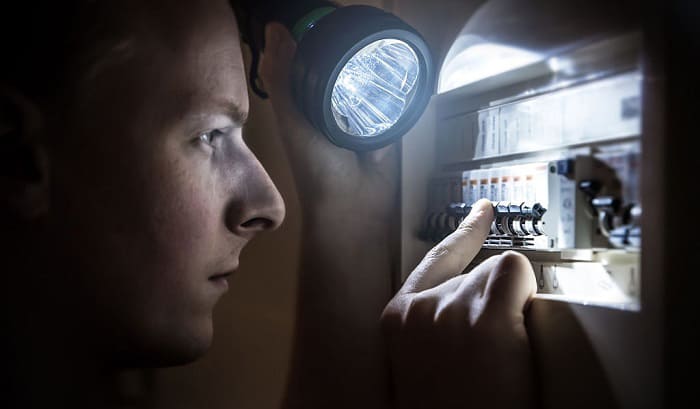
Do you want to use electricity without problems, but your light switch is a headache? If a circuit breaker trips when the light switch is turned off, most likely, it’s a result of a common wiring mistake. However, there are other reasons you should keep an eye on.
You’ll never know what will happen if you let this malfunction go unaddressed, so keep reading and see the listed possible reasons. It is necessary to determine your next step on this matter to maintain a healthy power source for your home.
Table of Contents
You Have a Miswiring in a Switch Loop Setup
A double throw switch is causing the problem, what if your switch is a single pole single throw, a loose wiring connection.
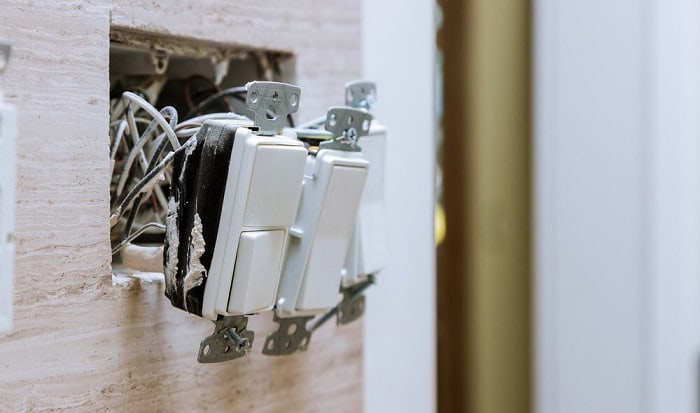
When you install lights, you buy new fixtures, switches, and perhaps a new set of wiring too.
Now you think you did the proper process — hot-to-hot wire and neutral-to-neutral wire, but in the end, the light switch trips breaker when turned off. Even though you reversed the way you plug the wires, the result stayed the same. This pain in the butt frequently happens when you have a switch loop set up.
A typical DIY guy mistake in a switch loop setup is when all black and white wires are connected. This miswiring causes the light to turn on even though the switch is off. Because it’s improper, it shorts the circuit and trips the breaker when the switch’s on.
To properly rewire this connection, you will need a marker and proceed to the following steps:
- First, the circuit breaker’s black wire connects to the white wire and other black wires that feed other devices.
- Remember to put a black marker on both ends of the switch and the light.
- Then, connect the circuit breaker’s white wire to the light’s and other devices’ white cables.
- Next, connect your switch’s black wire to the black wire for the lights.
- Finally, link all the ground wires together and to the ground screw from the lighting fixture and the box.
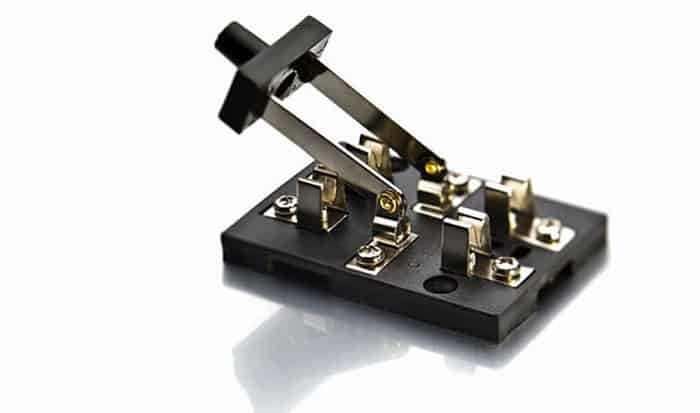
If your residence had a history of a bad renovation or electrical rerouting by an untrained contractor, your wirings might be in trouble. It is time to remove the cover panel of your switch box and investigate the situation of your switch inside the box.
A breaker that trips from an off light switch is not common among households today. This occurrence happens because of poor wiring of a light switch like the “Single-Pole, Double Throw” switch.
You’ll know you have this kind of switch when it doesn’t have ON and OFF markings on the switch toggle.
It’s a bad sign if your switch is leaning on the side of the grounded box where it is mounted. A switch is in an improper position when the switch pole screw lies against the switch box and the runner is shorted, which causes the fuse to blow when you turn the lights off.
Also, the breaker will trip if the runner short circuits to the ground or neutral wire somewhere along the wiring’s terminus.
If you have double-throw switches for a three or four-way switch, look out for a shorted traveler wire. It’s possible a switch was removed, causing the travel wire to short-circuit ( Read now how to test a shortstop circuit breaker here ).
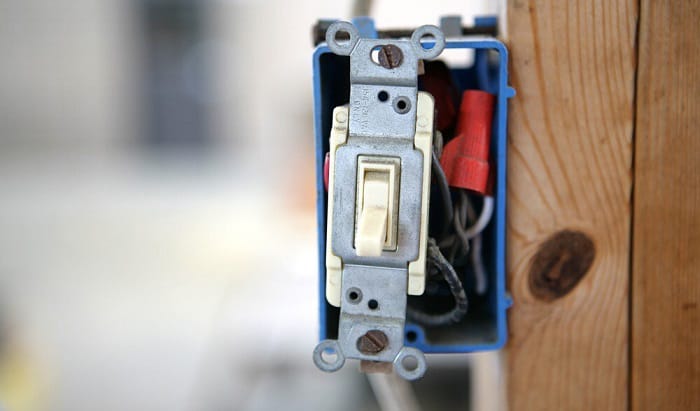
A standard single throw switch is a typical switch for a light fixture. You can typically find this at home with three screws for hot wires and a ground wire. Its clear difference from a double throw is that the switch toggle has an ON and OFF indicator.
Now, what’s the catch when you have a single pole, single throw switch? Will you have the same dilemma as with the double throw? Well, technically, the answer is yes. You can still experience a problem where a breaker trips when switch is turned off, but for other reasons.
If it’s a standard switch, it is easy to blame the button itself when you have a difficulty like this. The controller can be defective due to a manufacturing failure. However, a simple wiring mistake can trigger the breaker to trip just by turning the switch off.
If the ground wire and the hot wires are close enough to each other, toggling the switch can cause a slight movement that contacts them, then BOOM, a ground fault.
There’s also a possibility that the switch is in neutral. Keep an eye on this wiring mistake because you’re turning the power to the neutral and not the hot wire. Reverse wiring is a huge no-no, so try to fix it as soon as possible.
The fourth and simplest possible reason is a loose wire. Just like other devices at home, your switch gets old, and so does your breaker. When an electrical safety device comes to the point where you’ve been using it for ages, its wiring will eventually give up.
Sloppy wiring of an old switch can cause a breaker to trip, even with the slightest movement of switching it off. Like other issues stated earlier, a loose connection triggers a ground fault or a short circuit .
Furthermore, general wear and tear to your breaker and switch wirings result in repetitive breaker tripping. If you think loose or faulty wiring is not a big deal, watch this video by Andrew Pace:
It is necessary to check your terminal screws and wiring insulations from time to time. Sometimes an old wire turns brittle, and its insulations become damaged, so never let this happen to your switch and CB.
Wiring on the brink of destruction won’t only compromise a breaker but also increase the risk of multiple hazards. Always mind your safety.
There are four possible reasons why your circuit breaker trips when the light switch is turned off. Check if you have a switch loop setup, double/single throw switch, or loose wiring connections. These will help you determine a specific matter causing this problem.
If it’s the wiring that causes the problem, proceed on a safety action immediately.
Addressing an electrical problem is vital for the welfare of our homes. Never take safety for granted, and face the trouble as soon as you can.

I am Edwin Jones, in charge of designing content for Galvinpower. I aspire to use my experiences in marketing to create reliable and necessary information to help our readers. It has been fun to work with Andrew and apply his incredible knowledge to our content.
Light Switch Trips Breaker When Turned Off | Causes and Solutions
Light switch tripping breakers even when turned off might be one of the irritating problems to deal with while working on electrical issues. Even though it is not a common occurrence, it does occur, especially in older construction residencies.
In this informative article, we will dive into the root causes of this issue and provide practical solutions to resolve it.
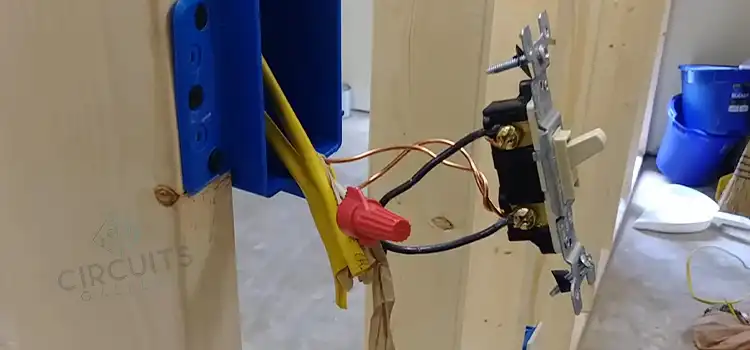
- Why Does Your Light Switch Trip the Breaker When Turned Off?

Figure: Tripped Breaker
There might be several reasons behind this dilemma, such as faulty wiring, defective switches, or the circuit being overloaded when the light is turned on.
Faulty Wiring
Faulty components and wiring are one of the primary causes behind this problem. If there is a fault in the wiring that results in a short circuit, it will cause the breaker to trip for safety reasons.
Consult a qualified electrician to inspect and repair this issue. If you’re not confident enough, you should not engage in tinkering with electrical wiring, which may lead to a disaster.
Defective Switch
The problem may lie in the switch itself. If the switch is old, broken, or malfunctioning, it may cause abnormalities when turned off.
If you detect any faulty switch, immediately replace the faulty switch with a new one. However, make sure the new switch is compatible with your electrical system and installed correctly.
Loose Connections
Loose electrical connections often result in breaker tripping. Improper and faulty connections can become loose due to a long time usage causing wear, tear or improper installation.
Proper maintenance and inspection of all the connections are necessary to avoid loose connections. If any loose connections are discovered, tighten and ensure they are properly secured.
Overloaded Circuit
If a circuit contains too many electrical devices, it draws more current than it can handle. The breaker can trip even when a switch is turned off.
If your electrical circuit is not distributing current properly, reconfigure and reduce the number of loads if needed.
Breaker Malfunction
There might be cases where the breaker is faulty, leading to unintentional trips.
Replace the breaker with a new one if you find that the breaker is faulty.
- To Conclude
Whenever you’re dealing with electrical issues, safety should be the top priority. Under any circumstances, do not troubleshoot or repair any electrical circuit if you’re unsure about the problem. Make sure to check if the runner creates a short circuit to the neutral or ground wire . Consult a qualified electrician in case you’re skeptical about the solution.
Subscribe to our newsletter
& plug into
the world of circuits
Share this content

A seasoned electronics enthusiast, Charles Clark is a key contributor to Circuits Gallery. From basic components to advanced microcontroller projects, Charles simplifies complex concepts with ease. His writings are a blend of expertise and passion, making electronics accessible to all. Whether it's circuitry or digital communication, Charles is the voice you can trust.
Similar Posts
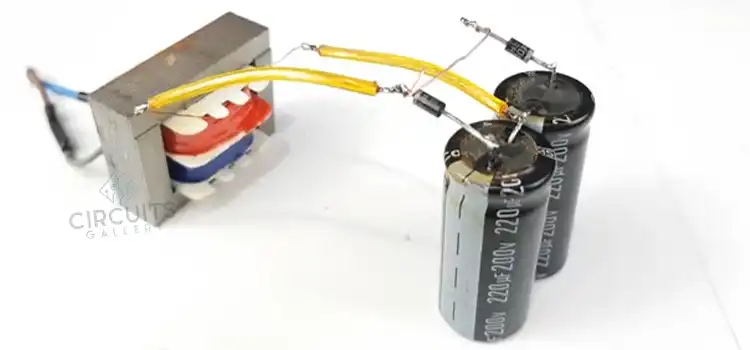
How to Reduce AC Voltage Using Capacitor | A Comprehensive Guide
One way to step down the voltage to adjust the voltage levels and match specific requirements is by using a capacitor in series with the circuit to reduce the AC voltage. In this article, we will explore the process of…
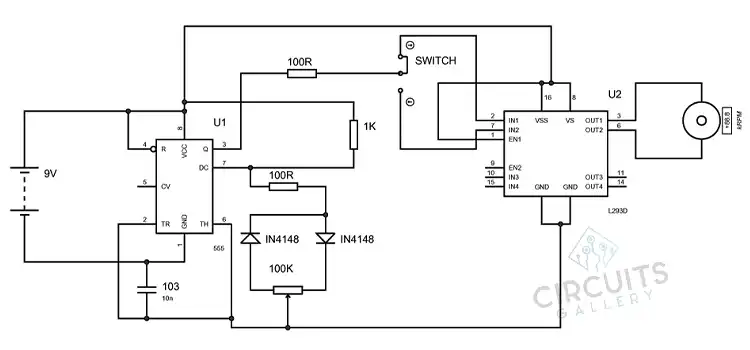
DC Motor Control Circuits | Motor Driver Projects
DC Motor (control) driver circuits are the essential circuit of the Robotics workshops. If you are a robotic beginner and looking for motor driver projects, then this article is just for you. We will discuss the basics of some motor…
![circuit breaker trips when i turn off light What Size Potentiometer for Volume Control [Everything You Need to Know]](https://www.circuitsgallery.com/wp-content/uploads/2023/09/What-Size-Potentiometer-for-Volume-Control.webp)
What Size Potentiometer for Volume Control [Everything You Need to Know]
Whether you’re adjusting the volume on your favorite music system, fine-tuning the tone on a musical instrument, or controlling signal levels in electronic circuits, the device you always need is the potentiometer. The best practical method for determining the ideal…
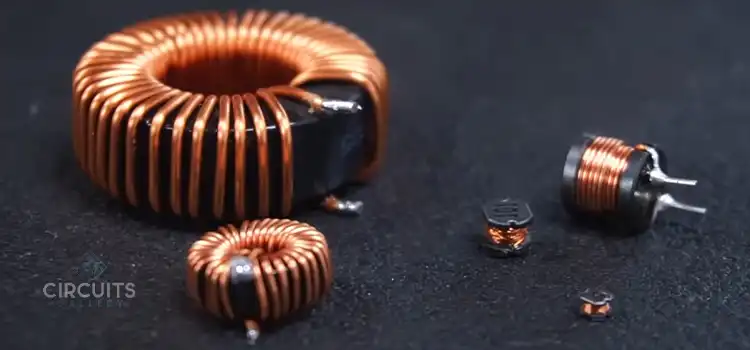
How to Design an Inductor | Step-by-Step Process
When creating an inductor, the physical characteristics like turns, diameter, and wire gauge are calculated depending on the design requirements, the core material, and other factors. The inductor’s electrical properties, including inductance, resonant frequency, and Q factor, are identified. Size,…
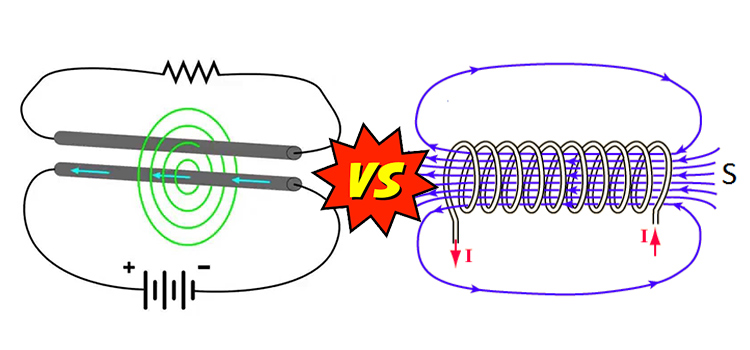
Impedance vs Inductance
Impedance and inductance have a specific and different impact during the flow of current in a particular circuit depending on passive elements present in that circuit. Impedance is a measurement of a circuit’s total opposition to electric current including both…
![circuit breaker trips when i turn off light [Explained] How Long Does It Take a Capacitor to Discharge?](https://www.circuitsgallery.com/wp-content/uploads/2022/12/How-Long-Does-It-Take-a-Capacitor-to-Discharge.jpg)
[Explained] How Long Does It Take a Capacitor to Discharge?
The time required to discharge a capacitor depends upon the period of the capacitor. After 5 time periods, a capacitor will be discharged almost completely. Practically a capacitor never discharges completely but goes very close to 0% of the initial…
Leave a Reply Cancel reply
Your email address will not be published. Required fields are marked *
Save my name, email, and website in this browser for the next time I comment.
Copy short link
- svg]:stroke-primary"> 826K
- svg]:stroke-primary"> 622K
- svg]:stroke-primary"> 246K
- svg]:stroke-primary"> 45K
Why Is My Circuit Breaker Tripping? 4 Potential Problems and Solutions
By: Glenda Taylor , Bob Vila , Evelyn Auer
Updated on Dec 21, 2023 8:55 PM EST
6 minute read
Photo: istockphoto.com
We may earn revenue from the products available on this page and participate in affiliate programs. Learn More ›
Q: Every few hours—sometimes minutes!—my living room and one side of my kitchen lose electrical power. I’ll check the breaker panel and, sure enough, a circuit breaker has tripped…again. Should I call an electrician, or is there a simple DIY fix I can try first?
A: While it’s frustrating when a circuit breaker keeps tripping, they are important safety mechanisms. Designed to shut off the electrical current when something goes wrong, circuit breakers are one of the best ways of protecting a home from an electrical fire. “When a circuit breaker trips, typically it is because we use too much electricity, which causes it to overload and turn off,” says Christopher Haas, expert electrician and owner of Haas & Sons Electric in Millersville, Maryland. For those who need an electrical panels 101 refresher course or aren’t sure how to reset circuit breakers, each breaker has an on/off switch and controls a separate electrical circuit in the home. When a breaker trips, its switch automatically flips “off,” and it must be manually turned back on to restore electricity to the circuit. For those wondering, “Is it dangerous if a circuit breaker keeps tripping?” the answer is that it can be, depending on the source of the problem. An electrician can ultimately deal with the root issue, but a little sleuthing will reveal whether it’s something that’s easily remedied.
In many cases, the cause of a circuit breaking tripping is an overloaded circuit.
A circuit overloads when more electrical current is being drawn through the wires than they can handle, tripping the circuit breaker. If this happens, there may be a few additional signs:
- Buzzing noises coming from outlets
- Devices charging slowly
- Electrical outlets not working
- Flickering lights
- Scorch marks on outlets and light switches
If a circuit breaker keeps tripping in one room, homeowners can test for circuit overload by turning off all the switches in the affected area and unplugging all appliances and devices. After the breaker is flipped back on, the devices can be turned back on one at a time, with homeowners waiting a few minutes in between to see if the circuit remains on. If the breaker trips before all the appliances are turned on, the experiment can be repeated, this time turning them on in a different order. It may be necessary to do this several times to find out how many appliances can be operated at once before the circuit overloads.
“As a short-term solution, you can unplug unnecessary appliances to prevent tripping circuit breakers. You may still get some trips, but you can limit them by unplugging devices that you don’t need to use,” advises Dan Mock, vice president of operations at Mister Sparky , an electrical company with 90 locations in the U.S. The best long-term solution, however, is to pay an electrician for the cost to rewire the house and add additional circuits. The cost to replace an electrical panel is about $1,274 on average.
Other times, the issue may be caused by a short circuit.
A “short” circuit means that two wires that should not be coming into contact are inadvertently touching, triggering a sudden surge of electricity through the wires. A short can occur in an outlet, a switch, or within an appliance if wires are loose or have been chewed through by mice or pets. Some signs of a short circuit include:
- Popping sounds
- Discolored outlets or switches
- Burning smells
Testing to see if an appliance has a short is similar to testing for an overloaded circuit. When an appliance that has a short in its wiring is turned on, it will immediately trip the circuit. Homeowners can also try plugging it into an outlet in a different room. If the breaker for that room trips, there’s a short in the appliance (if it’s unclear what breaker goes to what room, the breaker can be identified with one of the best circuit breaker finders ). Electrical shorts can be a major fire hazard, so it’s a good idea to call a licensed electrician for this circuit breaker repair. It’s wise to stop using the outlet or appliance until a pro takes care of the problem.
Another potential cause of a circuit breaker tripping is a ground fault.
A ground fault occurs when the electricity running through a home’s wiring diverts from the wiring loop and travels to the ground, usually due to faulty wiring or water infiltration in an outlet or switch box. Water is a conductor, which is why walking through puddles is often listed as something not to do in a power outage in case of downed power lines. Once water makes contact with wires, electricity can jump from the wiring loop and follow the water trail. This creates a surge in electricity leading to a tripped circuit breaker. If a person comes in contact with the electricity that is on its way to the ground, this can result in electrocution. Homeowners may notice a few signs of a ground fault, including:
- Tripped GFCI (ground fault circuit interrupter) outlets;
- A burning smell coming from an outlet; and
- Lights flickering.
Newer electrical breakers have features designed to protect against the danger of ground faults. According to Haas, “Ground fault breakers sense electricity going to earth as opposed to going through the wires of the circuit. You’ll find [these] for bathrooms, kitchens, garages, exteriors, and basements.” GFCI outlets are another safety feature that shut off the electric current within a fraction of a second of sensing a ground fault.
If a ground fault is the problem, the cause of the errant water must be discovered and repaired, and any damaged wiring must also be replaced. It’s also a good idea to install GFCI outlets in rooms where water is commonly used. A GFCI outlet costs $210 on average.
Sometimes a bad or worn-out circuit breaker can be the culprit.
In some cases, the circuit breaker itself may be faulty. Breakers that are old, damaged, or were installed incorrectly may trip frequently for no apparent reason. Alternatively, faulty breakers may not trip when they are supposed to, leaving the home at risk of electrical fire. Some signs of a bad circuit breaker include:
- The circuit breaker getting hot and tripping frequently;
- The circuit breaker won’t reset;
- It has been over 10 years since the breaker was last serviced; and
- The breaker has scorch marks.
An important electrical safety tip to keep in mind is that resetting a breaker over and over again can cause what is called an arc flash, which is a small electrical explosion that can be deadly. If resetting the breaker once does not remedy the issue, it’s a good idea for the homeowner to hire an electrician near them who knows how to replace a circuit breaker safely. Mock warns, “Don’t take any chances with circuit breakers. Instead, call a licensed electrician who knows the safe ways to replace breaker boxes, upgrade circuits, and diagnose potential electrical problems in your home.” Wiring a breaker box is a job to leave to an experienced electrician.
A professional electrician can help determine the specific cause of a frequently tripping circuit breaker.
Most circuit breaker problems—aside from those explained in the sections above—will need to be inspected and addressed by a licensed electrician. According to the Electrical Safety Foundation International (ESFI) , each year “thousands of people in the United States are critically injured and electrocuted as a result of electrical fires, accidents, [or] electrocution in their own homes.” While homeowners may be tempted to save on electrician costs by attempting circuit breaker replacement or repair themselves, electrical work is not suitable for casual DIYers. “Yes, you have to pay, but you can save many hours of head-scratching by hiring an electrician. Electricians will also have all the right tools for diagnosing and repairing the circuit,” Haas adds. “Lastly, they will come with a warranty/guarantee should something arise, and they will typically return at no additional cost.”
Anker’s New Home Battery Tower Is a Sleek, Modular Step Toward Complete Energy Independence Anker’s New Home Battery Tower Is a Sleek, Modular Step Toward Complete Energy Independence
By: Chase Brush
The 20 Best Lawn Care Products for a Lush and Healthy Lawn The 20 Best Lawn Care Products for a Lush and Healthy Lawn
By: Deirdre Mundorf

Breaker Trips When I Turn The Light On – How To Troubleshoot
Breaker trips from light switch. I turn the kitchen ceiling light switch ON and the circuit breaker trips . I am assuming the light switch or the light fixture is the cause. What can cause the breaker to trip when the light switch is turned on?
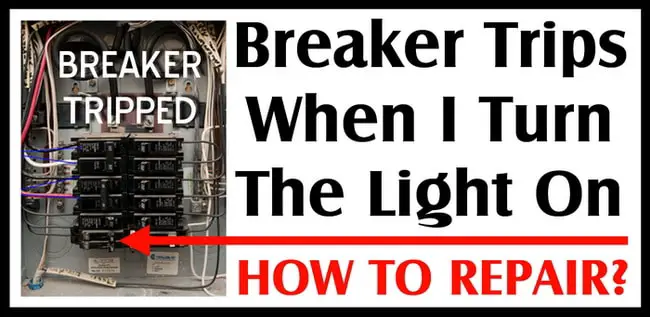
There are different reasons why a breaker will trip/reset when you turn on a light using a wall switch. See below for the reasons why flipping on a light switch could cause a breaker to trip/flip/reset.
SAFETY: Be sure to flip the breaker off when inspecting or troubleshooting any electrical issue. Use a flashlight or headlamp to safely inspect the area. Use the appropriate tools/gloves when working with electrical components. It is recommended to read this complete page before you begin troubleshooting your electrical issue.
Quick Troubleshooting: Start by turning the breaker OFF. Check the light switch by removing the switch cover. Fix any wires that are loose or damaged. Check the light fixture for any brittle/damaged or loose wires. If both the light switch and light fixture are wired properly, next inspect the wiring within the circuit. Most “breaker tripping” issues in this case involve the light switch and or the light fixture. For more detailed information keep reading below…
Recently replaced the light switch or fixture? If you have replaced the light switch or light fixture with a new one and the breaker trips when you turn the light on, the switch or fixture is most likely wired incorrectly. Turn off the circuit breaker and rewire the switch or fixture. Use the wiring diagram that came with the light switch/fixture to wire it correctly.
Having electrical issues with your ceiling fan? Ceiling fans may vibrate connections loose and cause a tripping breaker.
What do I check to fix the breaker from tripping? To find out why the breaker trips when you turn the light on, check the wiring, the light fixture, and the light switch. Inspect all components to be sure the wiring on the light fixture and light switch are not loose or damaged. Check the switch and fixture for the correct wiring with no shorts to neutral/ground. All of these conditions can cause the breaker to trip.
How To Fix Light Switch/Trips Breaker
Troubleshoot efficiently by checking the switch first. Remove the switch plate (2 screws) and check the switch with a flashlight. Inspect for any wiring touching the side of the box or other wires. Fix as needed, then check the light fixture and inspect the wiring for issues. If the issue goes beyond the light switch and light fixture, call an electrician to troubleshoot the problem.
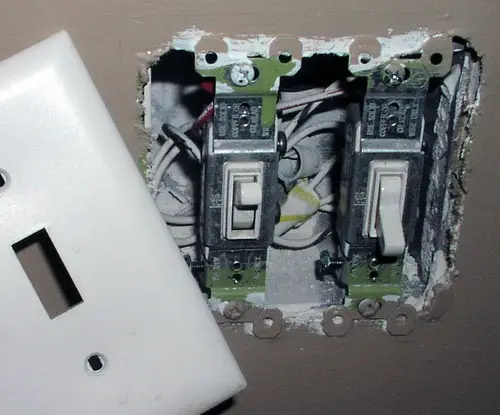
When a light switch trips the breaker, a faulty light switch or light fixture is usually the cause. A wire may have come loose at the switch or fixture and is shorting out the hot wire. Always check the switch and fixture first.
Also check any GFCI receptacles that are on the circuit for a malfunction or fault.
If you recently hung a picture or put a nail/screw through the wall, this is likely your issue as a nail or drill bit may have damaged the wiring. If a nail or screw has damaged the wire, you can replace the wiring around the fault by using junction boxes for the splice.
Why Does Light Switch Trip Breaker?
See below for the reasons why a breaker can trip and what may be causing the problem. There can be more reasons but these are the most common/average.
Light Switch Can Trip Breaker When:
- Light Fixture Fault
- Light Switch Is Faulty
- Wire Connections Are Loose
- Short Circuit Issues
- Ground Fault Problems
- Nail/Screw Through Wiring
- Rodent Chewed/Damaged Wires
- Faulty GFCI Receptacle
Reasons Light Switch Trips Breaker
1. Light Fixture Fault If a light fixture is faulty, a breaker can become overloaded. The wires in an old light fixture can fall apart and cause a short or ground out. Turn off power before checking the light fixture for damage. Replace the light fixture if found to be faulty.
2. Light Switch Is Faulty A light switch that has become faulty can short out and trip a breaker. An old light switch can crack and become unusable and cause the breaker the flip. The wires can become brittle and cause a circuit overload or a short. Turn off the breaker when checking the light switch. Replace the light switch if found to be faulty.
3. Wire Connections Are Loose If any of the wires become loose it can ground out and short circuit causing the breaker to trip/reset. Remove power, remove cover if applicable, and inspect the terminal screws on the switch to be sure they are not loose. If loose, tighten the screws and be sure they are secure. Be sure terminal screws are tightened all the way down.
4. Short Circuits A wire is contacting another wire and current flows through and flips the breaker. Wires can become brittle and the insulation can fall off. Inspect all wires to be sure there are no short circuits. Replace any wiring if you find it to be brittle and or the insulation has become brittle and falling off. This causes grounding and shorts.
5. Ground Faults This happens when a live wire comes in contact with a metal area of the switch housing or similar. This can cause shock and also trip the breaker. Inspect all areas on the wiring to be sure there are no ground faults.
6. Nail/Screw Through Wiring If you have drilled into the wall to hang a picture lately, you may have drilled too deep and damaged a wire. This is a difficult scenario as the damaged wire will need to be repair and or replaced. It is best to call a pro at this point.
7. Rodent Chewed/Damaged Wires A rodent in the wall may have chewed on the wiring. This will cause damaged wiring and cause a short that will flip the breaker. The wiring will need to be repaired or replaced.
8. Faulty GFCI Receptacle Check any GFCI receptacles on the circuit for a malfunction. If the light switch wiring is going through a GFCI receptacle and the GFCI is faulty, this can cause a problem and trip the breaker. Replace the GFCI receptacle if found to be faulty.
More common electrical problems and solutions:
What To Do If Electrical Breaker Tripping In Your Home?
Microwave Oven Tripping Breaker
Power Out In One Room But Rest Of The House Has Electricity?
No Power To Outlets In One Room Or Wall
If you have read through this page and still have a light switch that trips the breaker, please describe your issue below and we will get back to you with a solution.
Please Share The Love

You May Find These Related Articles Helpful...
About the author, keith vetter, leave a reply.
- Default Comments (8)
- Facebook Comments
8 thoughts on “Breaker Trips When I Turn The Light On – How To Troubleshoot”
I just recently moved into a old family rental house and in the kitchen there is a ceiling fan light combo and a block off plate for the switch meaning no switch. Well I got tired of having to pull the cord while walking slowly to try and not trip in the dark. I pulled the cover off the wall and have old 2 wire 1 yellow or white and 1 black both capped off. So I thought easy enough and hooked a switch up to it not thinking. The light and fan have power so putting a switch here will do nothing. Well acted without using common sense and installed a switch, when the switch is off lights and fan working as they were before, when I flip the switch on it throws a breaker and the light and fan turn off. So I took the fixture down and it’s wired White wire to white wire green capped black to black and in the same wire nut black to blue there is 4 different wire strands coming into the ceiling box all 2 wire – black and white all besides 1 set are wired together and then to the fixture. Another reason I’m putting in a switch is because we’re thinking about moving the fan and light to the living room and putting a standard light fixture, we can’t do that if theirs no switch it stays on constantly.
I have 6 spotlights in my kitchen ceiling , when they are turned on after some time the breaker will trip , tried installing new spotlights and it still tripping , any suggestions please
My lightswitch has 3 sets of wires coming into it, live feed from the box, run to the light, and continued circuit through to the outlets. I wired a piggy tail from the live feed to the switch and connected the light run and outlet run together with a piggytail. All whites are capped and all grounds are capped. I have to power to my light switch but no power to my outlets. When I flip the switch it shorts out the AFCI Breaker. I then checked to see if it is the light and so I hard wired the light to the live feed from the breaker panel and the light stays on while the switch is off but I still have no power to my outlets. We ran the wire and it all testes great, only time we started to have issues was when I had to change the Breakers out with AFCI Breakers.
Cornelius, Sounds as if there is an issue with the breaker that you are using for the lights. If the breaker for the lights or outlets is causing the main breaker to reset or trip, then check the light breaker for faults or wiring issues. You may want to have a professional assist you as working in a main breaker box can be a safety issue if you do not have much experience with high voltage. -RR
I have a problem, my main power box trips when I switch the lights breaker on but when the light breaker is off, all of the electrical outlets are working, please what’s cause of the problem?
installed new light circuit, when the switch is in off position and I flip breaker on, the 2 light fixtures are on, hit the switch to on a the breaker trips. Power is getting to the switch, in off postion the circuit works, turn the switch to on and breaker trips. I must have a wire from switch in wrong plsce or wrong on the first light of two in the circuit.
The breaker started tripping when I added a second light on a combination switch and the switch is also powering a second room and all my wiring is done right, I’m assuming is that the breaker is overloaded but I will like a second opinion or confirm my deduction
I hung a new ceiling fan, the old one was just wired into the neural side of the wiring, all hooked up on the white wire. I rewired the new one into the wiring like it should be, black to black, and white to white, now when i turn on the wall switch it trips a breaker.
Leave a Comment
Your email address will not be published. Required fields are marked *
Save my name, email, and website in this browser for the next time I comment.
Copy and paste this code: xajama *
Leave this field empty
This site uses Akismet to reduce spam. Learn how your comment data is processed .
is now Angi
- Join Our Pro Network
- Appliance Repair
- Carpet Cleaning
- Contractors
- House Cleaning
- Interior Painting
- View All Categories
- Concrete Repair
- Exterior Painting
- Garage Doors
- Gutter Cleaning
- Gutter Repair
- Home Builders
- Land Surveying
- Landscaping
- Lawn & Yard Work
- Sprinkler Systems
- Leaf Removal
- Pool Installation
- Tree Service
- Basement Waterproofing
- Junk Hauling
- Moving Companies
- Pest Control
- Pressure Washing
- Septic Tanks
- Services Near Me
- Basements & Foundations
- Bathroom Remodel
- Chimneys & Fireplaces
- Garages & Driveways
- Heating & Cooling
- Home Construction
- Home Exteriors
- Home Health Hazards
- Home Interiors
- Home Security
- Kitchen Remodeling
- Outdoor Living
- Real Estate
- Storage & Organization
- Waste Management
- Project Cost Center
- View All Articles
- Solution Center
How To Find What Is Tripping My Circuit Breaker: 5 Causes to Check
Less power can mean more problems, but finding the source of the trip can solve them

Your circuit breaker may continue to trip if it encounters a ground fault surge, a short circuit, or if it overloads.
If you live in an older home, the tripping may be the result of outdated wiring or an older electrical panel.
If resetting the breaker doesn’t solve the problem, consult a licensed electrician.
Your circuit breaker has the important task of disrupting electricity to prevent shocks, fires, and other disasters—but sometimes it’s not clear why a circuit breaker trips . Learn how to find out what is tripping your circuit breaker and some common solutions to consider.
1. Ground Fault Surge
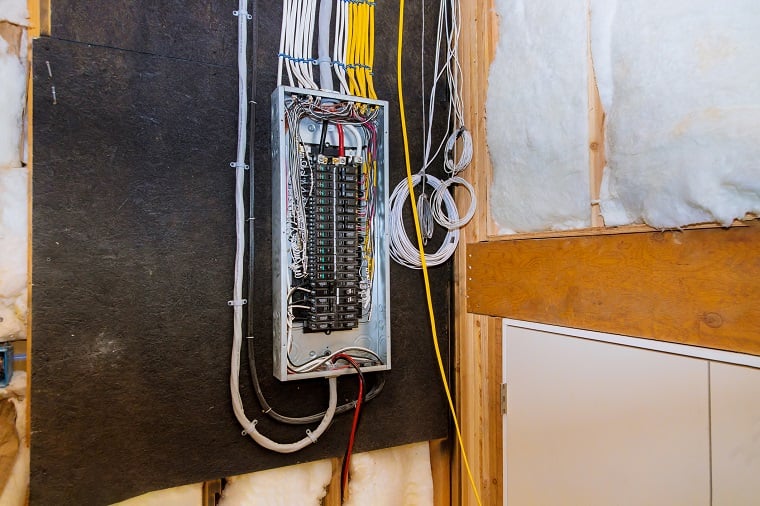
A ground fault is when the flow of electricity goes astray and gets redirected to the ground without resistance. This type of fault happens when a “hot” wire contacts a grounding wire or any grounded part of the system, such as the metal electrical box. When your circuit breaker detects the sudden surge in electrical flow, it will cause the breaker to trip.
If someone is standing on the ground where the electricity gets directed, there’s a high risk of electric shock, especially if the ground is damp. This is also a common reason why your circuit breaker trips randomly. If you suspect a ground fault, contact a local electrician to investigate the issue.
2. Short Circuit
Short circuits resemble ground faults because they, too, involve a misdirected flow of electricity. These happen when a hot wire contacts a neutral wire in an electrical outlet, leading to an overloaded current within the circuit. This reaction creates heat, which will trip your breaker to prevent a possible fire.
If you suspect a short circuit, unplug your appliances and check the wires for melted coverings. You might also notice a burning smell coming from the outlet. Call in a professional electrician to find the source of the problem.
3. Circuit Overload
Circuit overloads are the most common reason that a breaker trips. Sometimes you want to microwave some leftovers and blow-dry your hair at the same time. Sure, you’re killing the multitasking game, but this is the perfect recipe for a circuit overload. Certain high-voltage appliances can trip circuit breakers easily, so check out what you plugged in.
Your electrical wires have a finite capacity for electricity, and can only handle a certain flow. When that load gets exceeded, your breaker will cut it off. This action prevents the wires from heating to a dangerous level, potentially causing an electrical fire.
4. Outdated Wiring
If you have an older home with older electrical wiring that hasn’t been updated to meet the needs of more modern appliances, it could lead to more frequent circuit breaker trips. In this case, you could benefit from having a licensed electrician inspect your wiring to see if it’s up to code and if it needs to be updated.
The cost to update your home’s wiring is around $1,500 if it’s a simple job or closer to $10,000 if it’s a whole-house project. A major aspect of updating the wiring is getting the necessary permits, which can also be costly. If the cost is enough to scare you, just keep in mind that your wiring should only be an issue if the home was built before 1960.
5. Outdated Electrical Panel
In some cases, your circuit breaker may continue to trip because of a malfunctioning electrical panel. Old age or a manufacturing defect could cause the breaker to shut off even when it’s not overloaded or experiencing a short circuit. A small issue with the electrical panel can be repaired by an electrician, but if you need to replace the electrical panel , expect to pay around $1,230 on average, or $500 on the lower end to $4,000 on the higher end.
What To Do When Your Circuit Breaker Keeps Tripping
If your circuit breaker continues to trip, try resetting the breaker to see if the problem continues. You could be dealing with an appliance that requires more power than your breaker can handle. If that’s the case, you may need to upgrade your electrical panel to fit the needs of your appliances and other electronic devices so that your power doesn’t keep going in and out.
However, if the appliances are not to blame, call in your local electrician to assess your power problems and see what can be done to resolve them. Frequent tripping can be a sign of a more extensive and more dangerous issue that could lead to electrical fires or shocks, so it’s best to call in a pro if resetting doesn’t seem to make a difference.
How to Prevent Recurrent Circuit Breaker Trips
Whether you upgrade your electrical panel or have an electrician make a few repairs to your wiring, there are a number of steps you can take to prevent future trips in your circuit breaker. These include:
Limiting the number of devices plugged into one circuit
Unplugging devices when they’re not in use
Putting surge protectors in place
Install GFCI outlets in rooms prone to moisture, such as kitchens and bathrooms
Have your electrical systems inspected yearly to make sure they’re in good condition and up to code

Circuit Breaker Tripping: Troubleshooting Guide
Hubert Miles | Licensed Home Inspector, CMI, CPI
Updated on January 5, 2024
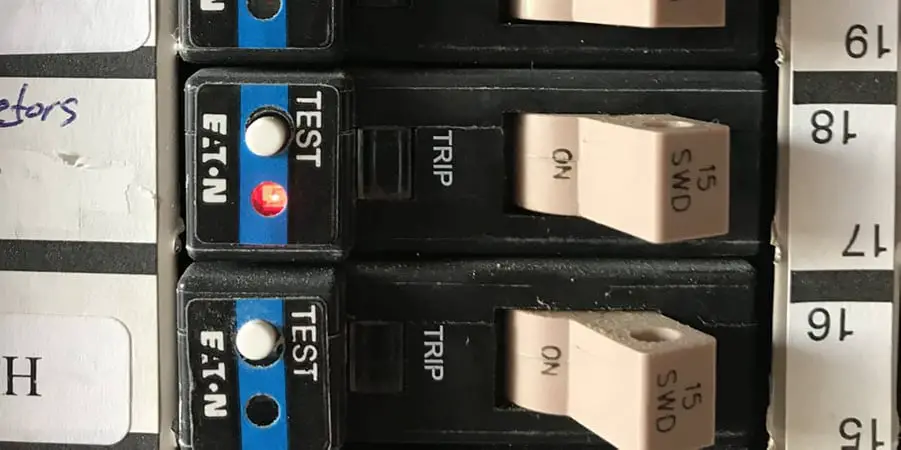
A circuit breaker tripping results from short circuits, overloaded circuits, and ground faults. In each case, an unintended excessive flow of current triggers the trip. You must reset the circuit breaker by flipping it back on to restore power.
Circuit breakers trip because they cannot handle the amount of current running through them. Tripping the circuit breaker interrupts the flow of electricity and protects your devices or appliances from damage.

Get FREE estimates from licensed electricians in your area today. Whether you need to replace an outlet, hang a ceiling fan, a new electrical panel, or repair wiring, We Can Help!
Without electrical circuit breakers , the possibility of electrical fires would be much higher.
This guide looks at what causes circuit breakers to trip, what you can do, and how to identify a bad breaker.
What Would Cause a Circuit Breaker to Trip
There are three leading causes of circuit breaker trips:
- circuit overload
- electrical faults (i.e., ground faults and arc faults)
- short circuits
Below are factors that can cause circuit breaker trips.
Circuit Overload
A circuit overload happens when the flow of electric current running through the circuit exceeds the amperage of the devices it serves.
For example, if your microwave is a 12.5 amp appliance, you can run it on a 15 amp circuit. That means your microwave is safe as long as the amperage running through the circuit is 15 amps .
However, if the circuit receives an excessive electrical load over 15 amps , it will automatically trip to protect your device from damage. If the circuit doesn’t trip, the excess current will fry the circuit in your microwave.
Also, if you operate too many appliances and devices on one circuit, its internal mechanism heats up, causing the breaker to trip.
Circuit overload is the most common reason for breakers tripping.
Ground Faults
A ground fault occurs when the active wire comes into contact with a ground wire made of bare copper. Sometimes, this fault may happen when the hot wire touches the metal box connected to the ground wire.
Excessive current flows once the active wire touches the ground wire, flowing into the earth. If you step on the affected area, ground faults can cause shock and even electrocution. The uncontrolled flow of electricity will cause the circuit breaker to trip.
Arc Faults
An arc fault happens when exposed faulty wiring touches, causing the electric current to arc at the meeting point. As a result, sparks occur, which can ignite an electric fire.
A corroded or loose connection is the main culprit for arc faults. Circuit overloads, ground faults, or short circuits trip an AFCI (Arc Fault Circuit Interrupter) circuit breaker.
Arc faults result from damaged, loose, or corroded terminals and wires. The arc fault builds up over time as the heat due to the cable damage and terminals build up to the point of ignition.
Short Circuits
A short circuit occurs when an active wire touches a neutral wire, and the electrical current takes an unintended path of least resistance.
The common cause of short circuits is frayed wires coming into contact when the wires touch. The electrical current flow increases significantly, causing the circuit breaker to trip to stop the electricity from damaging appliances.
It is a short circuit because the current bypasses the proper circuit wiring channels and flows through a shorter, unplanned pathway.
Short circuits occur
- When insulation melts and wires are exposed
- Within appliances with damaged internal wiring
- Due to damaged and frayed extension or appliance cords
How do You Fix a Breaker that Keeps Tripping?
A dedicated circuit breaker tripping indicates too much current flowing through the wiring or connection to the outlet.
Here is a step-by-step guide to follow when you notice the first trip:
- Begin by turning off all the appliances and unplug electrical devices from the outlet. Also, switch off light fixtures and unplug those that you can. This prevents any appliances from damaged when the breaker is reset and a sudden surge of power comes through.
- Open the circuit panel or box and locate the on and off buttons of the circuit breaker. You may notice an orange or red color on the breaker when it is off.
- Flip the switch from off to on to reset the circuit breaker. Once the breaker is reset, you can switch and test the appliances to see if the electrical power is flowing.
- Keep safe as you reset the breaker by working from the side of the electrical box instead of the front. That way, you will avoid any sparks (should there be any) when you switch the breaker back on.
- Some people prefer to switch the main electrical switch when working on the circuit breaker for added safety.
Types of Circuit Breakers
Standard circuit breaker.
Standard circuit breakers monitor the modulation of the electric current coming into your devices and appliances.
This circuit breaker stops the current from flowing when it detects the excessive flow of electricity.
Standard circuit breakers come in two forms:
- Single-pole circuit breakers
- Double pole circuit breakers
Single-Pole Circuit Breakers
Single-pole circuit breakers are the most common breakers in homes and buildings. They monitor the electric current’s flow in one wire and trip if that wire experiences a very high influx of electricity.
These breakers deliver only 120 volts and work well for 15 to 30 amp circuits. Single-pole circuit breakers come with one switch in the back.
Double-Pole Circuit Breakers
The double-pole circuit breakers monitor the current in two wires simultaneously. You will notice two switches on the back of these breakers.
The double-pole circuit breakers will trip even if only one of the wires receives too much current. They can accommodate between 15 to 200 amps while delivering 240 volts.
Single-pole breakers are a good fit for lighting fixtures and other standard home outlets. On the other hand, double-pole breakers work for larger appliances like dryers and washing machines.
Ground Fault Circuit Interrupter (GFCI)
The GFCI circuit breaker interrupts the line due to ground faults. They trip when the current starts to follow an uncharted path into the ground. These ground fault surges occur when a foreign conductor, like water, comes in contact with a receptacle .
At the same time, they offer protection against circuit overloads and short circuits.
GFCI circuit breakers come built into specialized outlets required for wet areas in the home, including :
- Outdoor areas like the balcony, patio, porches, and decks
- Laundry rooms
- Swimming pools
- Six feet from a sink
- Six feet from the bathroom
These breakers help prevent shock or electrocution should the electrical outlet contact water.
Arc Fault Circuit Interrupter (AFCI)
The AFCI circuit breaker detects normal and abnormal arc faults, so it will trip when it detects a dangerous arc fault that can cause a fire.
The AFCI circuit breaker doesn’t work to protect devices and appliances plugged into an outlet. It works to prevent electrical fires due to faulty connections and wiring. The internal sensing mechanism in the circuit breaker senses the conditions of an electric arc, and the circuit trips to avoid an electric fire.
AFCI protection can also be built into an outlet. The National Electrical Code (NEC) requires these types of breakers to feature in :
- Common rooms
- Laundry areas
AFCI and GFCI circuit breakers can co-exist and complement each other for the best protection.
Combination All Fault Circuit Interrupter (CAFCI)
The CAFCI breaker senses and reacts to any electrical fault, including ground and arc faults.
CAFCI is a relatively new technology that meets new NEC requirements for circuits requiring arc and ground fault protection.
Do Circuit Breakers Get Weak?
A circuit breaker can wear out and become weak. If a breaker trips frequently, the thermal or magnetic element can lose calibration, causing it to trip at lower amp loads than intended. A breaker constantly under thermal stress caused by overloading the circuit will eventually trip more frequently.
Let’s not forget breakers are not impervious to damage. As the internal mechanical parts wear out, they become very sensitive and may not hold under normal load amperage and temperatures.
Electricians refer to this as a bad breaker .
Will a Bad Breaker Keep Tripping
By definition, bad breaker malfunctions, so it will keep tripping until it is either replaced or rectified .
A licensed electrician performs this simple test to see if a breaker will keep tripping and determine if it can be repaired or replaced in the following steps.
- The electrician will switch off all the fixtures and appliances in the house. Also, unplug everything.
- Find the malfunctioning circuit breaker . The electrician will go to the electrical box and locate the breaker lighting orange or red or the one with the switch off.
- They will ascertain that it is the correct circuit breaker. After that, the electrician puts the breaker off.
- With the switch on, the breaker is back on as well. The electrician will plug the appliances into the outlet with the problem circuit breaker. Now, they will turn the devices and appliances on.
If the breaker trips, the electrician will investigate the circuit’s current amount. The breaker is bad if the current is according to the appliance’s rating.
How You know if a Circuit Breaker is Bad
Breakers do wear out after a while. It has a problem if the breaker doesn’t stay on after resetting it.
Since the circuit breaker controls the electric flow in the house, it is essential to monitor it and catch signs that it has gone bad early.
Here are key signs that denote a bad circuit breaker :
It Frequently Trips
Frequent tripping could be because of a bad breaker. After tripping and resetting, your circuit breaker should stay on unless it detects high current flow.
To ensure that the issue is not the electricity but the circuit breaker, call an electrician to examine your electricity’s flow and determine whether it is the cause of the constant tripping.
If it is not, then the circuit breaker is the problem.
The Breaker Overheats
Electrical systems will heat up when active. Typically a breaker can heat to about 60°C (140°F) before problems arise.
Terminations for standard rated breakers: UL 489 Paragraph 7.1.4.2.2 says the temperature rise on a wiring terminal at a point to which the insulation of a wire is brought up as in actual service shall not exceed 50°C (122°F). Terminations for 100% rated breakers: UL489 Paragraph 7.1.4.3.3 says the temperature rise on the termination shall not exceed 60°C (140°F). Handles, knobs, and other user surfaces: UL489 Paragraph 7.1.4.1.6 says the maximum temperature on handles, knobs, and other surfaces subject to user contact during normal operation shall not exceed 60°C (140°F) on metallic and 85°C (185°F) on nonmetallic surfaces. Source: https://www.clipsal.com/faq/fa173839
Call an electrician immediately if the breaker becomes too hot.
There are Scorch Marks
Scorch marks around receptacles, appliances, and the electrical box should tell you your circuit breaker has gone bad.
The burn marks indicate that wiring insulation has melted off and the circuit wires are now sparking and emanating heat or fire. That means that the circuit breaker did not interrupt the excess current and reached the wires and burned them.
You may see melted wire sheathing on the wire where it connects to the breaker.
Professional electricians can use a thermal imaging infrared camera to locate the heat source. The infrared camera allows them to pinpoint the problem area through the walls and other construction material.
A Burning Smell
Sometimes you may smell the insulation burning, but no scorch marks are present to denote which outlet is the problem.
With the help of the infrared camera, an electrician can help locate electrical issues.
If you encounter a burning odor, shut off the main power and call for emergency service from an electrician.
The electrical wires burn because power surges through the circuit, melting the wire insulation.
What is Nuisance Tripping
Nuisance tripping is when a breaker trips without a fault to warrant the interruption to the electric current flow.
Nuisance tripping occurs due to several reasons:
Stringent Protection on Circuits
Sometimes the circuit is protected by stringent conditions that detect any variance as a fault and cause a trip.
Such stringent conditions can be tuned to accommodate the home’s or building’s electric needs.
A Highly Sensitive Circuit Breaker
In some cases, the circuit breaker has been set to susceptible settings so that they can detect even the slightest fault, even a minor average variance.
For example, the manufacturer can set an AFCI circuit breaker to sensitive standards to detect another circuit’s arc. This common issue may occur in a daisy chain where the circuit breakers connect in a linear series. There may be a faulty electrical outlet you are unaware of on the circuit. It is common for multiple rooms to share a breaker in older houses.
The Breaker Encounters Power Under Different Conditions
The variation in the current is normal, but the breaker responds to it by tripping because the flow is outside the breaker’s regular operation.
Your circuit breaker is tripping because the voltage it is encountering is not within the standard operation. You will need to adjust the circuit breaker or the voltage to eliminate nuisance tripping.
The Breaker Trips with Nothing Plugged in
A breaker tripping with nothing plugged in occurs when a hot, neutral wire is touching somewhere in the circuit. The common causes include frayed or damaged electrical wires, loose connections, faulty electrical receptacles, light switches , or dimmers.
Electrical wire damage happens when:
- wiring is chewed by animals such as rats, squirrels , raccoons, etc
- wire sheathing and insulation ages and become frayed
- wires rub against sharp edges such as punch-outs with missing grommets or wire clamps
Loose connections often occur when electrical wire nuts come loose or electrical tape wears out causing wires to touch.
Defective wiring can be anywhere along the circuit, so it’s best to contact a licensed electrician to troubleshoot why the breaker is tripping.
Replacing a Bad Circuit Breaker
- Check the electrical panel to see the compatible approved circuit breaker brands. Also, make a note of the brand of the electric panel . This is to help you determine if there are upgrades they could recommend for the hardware.
- Order online or go to the hardware store and purchase the breaker of the same voltage as the one you are replacing.
- Go and open the electrical box and switch off the bad breaker. Loosen the terminals and remove the wires using a pair of needle-nosed pliers. Ensure the pliers have rubber insulated handles to avoid shock or electrocution since you will use the pliers to grab the live wires from the terminal. That is a safety measure.
- Remove the bad breaker. Replace it with the new breaker and slip its clips into place. Remember to switch off the replacement breaker.
- Next, using the pliers, hold the wiring and tighten the screws on the terminal. It is crucial to ensure that the wires and screws in the terminals are in the right place.
- Turn the breaker on and replace the electrical panel cover.
Can a Breaker Fail Without Tipping
If you have a newer electrical panel , it’s not likely for a breaker to fail and not trip. However, in older breaker boxes like Federal Pacific , the breaker failing to trip is common.
The main reason Federal Pacific was investigated by the Consumer Products Safety Commission (CPSC) was widespread structure fires involving breakers failing to trip when an electrical overload was present. They found that the circuit breaker contacts would fuse to the bus bar.
Modern breakers will trip when a failure occurs as an added layer of safety. Most older breakers did not have these safeguards.
With AFCI breakers, if the Internal sensing mechanism fails, the breaker reverts to a standard breaker. The AFCI sensor mechanism will no longer work, but the breaker would still trip from overcurrent protection. Therefore, you should test the AFCI breaker regularly.
Conclusion
Listen to your circuit breaker . It’s alerting you of a problem when it trips. That communication could be a problem with the breaker itself, the circuit, or the amount of electric current coming into your home.
Hubert Miles is a licensed home inspector (RBI# 2556) with more than two decades of experience in inspection and construction. Since 2008, he has been serving South Carolina through his company, Patriot Home Inspections LLC. As a Certified Master Inspector, Hubert is dedicated to providing his expertise in home inspections, repairs, maintenance, and DIY projects.
Continue Reading

Watts to Amps Calculator: DC/AC Wattage to Amps Conversion

70 Amp Wire Size: Breaker & Wiring Gauge Guide

80 Amp Wire Size: Breaker & Wiring Gauge Guide

200 Amp Wire Size: Service Length & Wiring Gauge Guide

10/2 or 10/3 Wire for Mini Split: A Professional Guide

GFI vs GFCI: Understanding the Key Differences

Founded by Hubert Miles, Certified Master Inspector
Home Inspectors
Calculators
Privacy Policy
Terms of Service
©2024 Home Inspection Insider 898 Whispering Pines Rd, Johnsonville, SC 29555 843-250-1882


Light Switch Trips Breaker: What To Do?
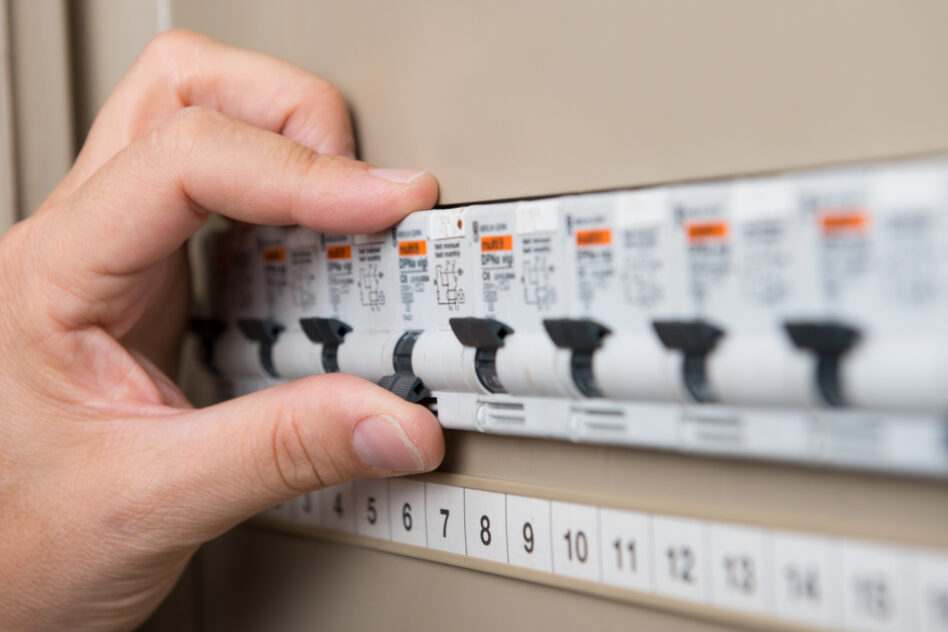
Don’t you just hate it when a light switch trips the breaker? Aside from being annoying, the underlying issues may cause serious damage. What can you do about it, and how to keep it from happening again? Let’s find out!
What Does a Tripped Breaker Look Like?
Get your hands ready, check for water deposition, don’t touch a breaker switch with high amperage, turn appliances and devices off, adjust your circuit breaker, check your breaker panel, know when to call an expert, avoid overloading one circuit, check and replace old wiring, install your light switch properly.
When you open your electrical panel, there should be multiple breakers on a board.
Each of the breakers in the panel regulates a different electrical circuit in your house and has a switch with numbers printed on it. Typically, each one should be labeled with the name of the area that it controls.
Keep in mind that power cannot flow through the circuit until the switch is manually turned back on after a breaker trips. This causes the switch to flip to the “OFF” position automatically.
For example, if the light switch that caused the trip is located in the kitchen, you can easily locate the breaker switch labeled “Kitchen.”
You’ll probably see the “Kitchen” breaker switch tipped to the “OFF” side or right in the middle between “ON” and “OFF.”
What Are the Safety Precautions to Take?
Before we get down to business, let’s make one thing clear: safety is still our top priority.
You may be in a rush to get your problem fixed, but temporarily losing your power supply is so much better than losing an eye or a finger.
Here are some safety tips to keep in mind:
Working on electrical systems with wet hands is extremely dangerous. So, we recommend that you start by drying your hands properly before troubleshooting your light switch.
Then, you can wear protective goggles or use electrical-insulating gloves.
Water won’t always accumulate on the breaker, but it does happen occasionally. That’s why it’s always good to examine your panel carefully. If it seems wet, don’t touch anything.
You might notice a number on the breaker switch that indicates the amps or the measure of electrical current that flows in that circuit.
If the number is 25 or above, it’s better to leave it to the professionals. Meanwhile, if your breakers aren’t labeled at all, it isn’t recommended to attempt to reset them.
Sometimes, simply flipping your light switch can trigger a trip on your circuit breaker.
This is a common issue with newly installed lighting systems. However, circuit breaker trips from flipping a light switch may also be caused by a short circuit due to faulty or damaged wires.
Either way, let’s take a look at how you can approach the tripped breaker.
Start by unplugging all appliances, lamps, and other gadgets in the affected area.
Go to your electrical service panel and check if a particular breaker has tipped to the “OFF” side.
In some cases, the breaker may not tip completely to the “OFF” position and may sit between both sides. When this happens, you can move the switch over to “OFF” first before pushing it back to the “ON” side.
Now, there is a possibility that the switch will automatically tip back to “OFF” after you’ve just switched it to the “ON” side. If that’s the case, don’t try to reset your breaker once more. Instead, seek help from an expert.
After successfully resetting your breaker, flip your light switch to see if the issue is fixed.
If overloading is the culprit, your power will come back after switching your lights on or plugging your devices one at a time.
There may be instances when the light switch doesn’t turn on, but other plugged-in equipment may receive power. If that happens, you can suspect that the problem might have originated from your light switch.
If the previous steps don’t cut it or you’re uncertain about the root cause, it’s best to call your electrician.
Having your breaker trip twice in a row should already sound an alarm, and you shouldn’t try to fix the problem on your own.
The primary concern here is that repeatedly resetting your breaker due to recurrent trips can be risky and may result in overheating.
After all, serious complications and accidents are on the line, including the following hazards:
- Overheating of internal components that may lead to fires
- Visible damages like scorch marks on power outlets, sometimes with the presence of a burning smell and smoke
- Sparks on the breaker
- Odd clicks or buzzing sounds from the outlets or switches
How To Prevent Your Light Switch From Tripping the Breaker?
Since dealing with a light switch that trips the breaker is a hassle, you might want to check out these preventative tips and tricks:
Circuit overload is the main reason behind trips. That’s why it’s better to avoid plugging your bulb into one circuit with a ton of connected appliances.
Remember that using an extension cord to maximize connectivity will only make things worse. If you badly need to use multiple devices, try plugging your other devices into a different circuit connection or getting a new circuit installed.
Be sure to unplug devices or appliances that aren’t in use.
If your electrical wires have been sitting there for many decades and you start to experience frequent trips, they’re probably worn out.
You might even notice that rodents have damaged your wiring. So, it’s good to have your old wires replaced by an electrician.
We’d recommend double-checking that you’re using compatible fixtures before installing new lights or replacing any part of the lighting setup.
Then your electrician can check that all screws are all tight and wirings are connected properly to reduce the risk of tripping.
Related Articles

9 Best Landscape Lighting Ideas For Your Backyard
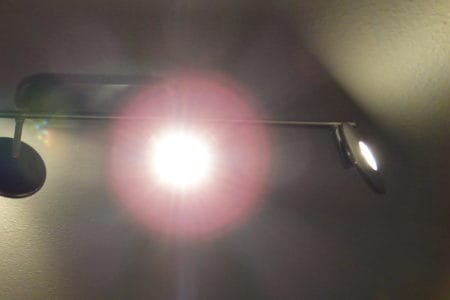
LED Lights Too Bright? How To Reduce The Blinding
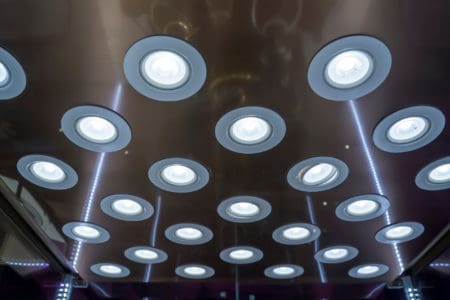
4-inch vs 6-inch Recessed Lighting
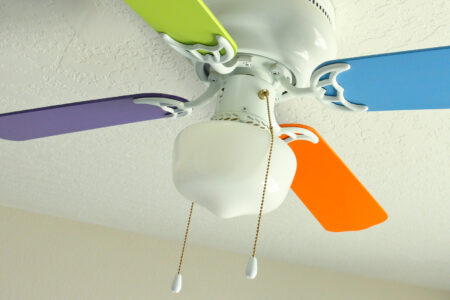
Can You Use A Dimmer Switch On A Ceiling Fan?
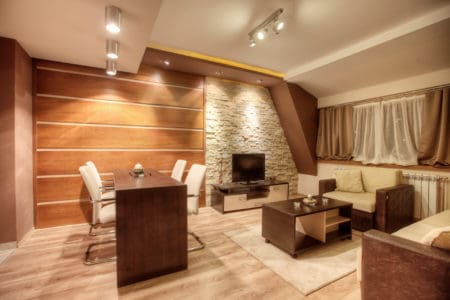
Lumen Calculator for every Room

Fog Lights vs Headlights: What’s The Difference And What’s Better?
How to Reset a Tripped Breaker
What to do when a circuit breaker trips.
Lee has over two decades of hands-on experience remodeling, fixing, and improving homes, and has been providing home improvement advice for over 13 years.
:max_bytes(150000):strip_icc():format(webp)/headshots_FINAL_lee-wallender-739d21a7b6ed4aa1b895c684e193494c.png)
The Spruce / Kevin Norris
What Causes a Tripped Circuit Breaker
Safety considerations, how to avoid tripped breakers, when to call a professional.
- Total Time: 5 mins
- Skill Level: Beginner
- Estimated Cost: $0
A power breaker trip is an annoying occurrence when the power shuts off and you can't use the microwave, lights, or router. A breaker trip is far more than simply annoying when you need that router to send off a time-sensitive work assignment or when medical devices are diverted to time-limited standby power. Fortunately, it's easy to fix a circuit breaker trip in just a few minutes.
Tripped Circuit Breaker
A tripped circuit breaker is when a circuit breaker automatically shuts off to prevent devices on the circuit from overheating or from receiving excessive power. A circuit breaker protects your home against damaging or harmful short circuits and overloads.
- Overloaded circuits : When too many devices are operating on the same circuit and are attempting to pull a higher power load than the circuit can carry, the circuit breaker will trip.
- High-power devices : High amp devices like microwaves , dryers , wall heaters , or A/Cs are turned on for sustained periods, they can cause a power breaker trip.
- Short circuits : In a short circuit, a powered or hot wire makes contact with a neutral wire or when wires are loosened .
- Ground faults: In a ground fault, a hot wire touches anything that is grounded, such as the side of a metal electrical box , an appliance, an outlet , or a bare ground wire.
Need more help? Talk to an electrician near you
Our partners can help you compare quotes from top-rated professionals near you
Get a Quote
Watch Now: How to Safely Reset a Tripped Circuit Breaker
Working around an electrical service panel or circuit breaker board can be dangerous. Your home’s entire electrical load is contained in that box, concentrated around the metal lugs where the service drop’s wires enter the box. Unscrewing and removing the inner dead-front cover within the service panel exposes the highly powered lugs.
What You'll Need
Equipment / tools.
- Circuit breaker directory (if available)
- Rubber-soled shoes
- Safety glasses
Instructions
Locate a flashlight.
Circuit breaker panels tend to be located in out-of-the-way locations with little, if any, ambient light. Find a flashlight. Use the light from a phone if necessary.
Turn Off Devices on the Circuit
Turn off all devices on the electrical circuit. This includes the device that may have caused the breaker to trip, such as a microwave, hairdryer, or A/C, plus all other devices on the same circuit.
Find the Electric Service Panel
The electric service panel, sometimes called a circuit breaker board, is a metal box with a door. The box may be inset in a wall, its face flush with the wall, or surface-mounted where the entire box is exposed.
Places to look: garage , closet, pantry near the kitchen, basement , mudroom, hallway leading to garage or backyard.
One clue is to first find the electric service drop from the main power lines. Usually, your home’s service panel is located below and nearby, on the inside of your home.
Open the Door to the Service Panel
Open the door to the service panel by sliding the plastic switch to the side or up. Next, swing the door open. Use the inset plastic switch as a handle to pull the door open.
Adhi Syailendra / Getty Images
Locate Tripped Breaker
The handle of a tripped circuit breaker should be in the middle position—not left or right. Visually or by feel, locate any breaker handles that differ from the right or left positions:
- Tripped breakers : Tripped circuit breakers have a soft or springy feeling when you lightly press them leftward or rightward.
- Live/active breakers : Breakers that are not tripped are either firmly left or right (depending on which side of the box you're looking at).
Certain breakers, such as Eaton breakers , trip to the off position, not the middle position. Check manufacturer's instructions for your particular product.
Turn the Circuit Breaker Handle to OFF Position
Flip the circuit breaker handle to its firm OFF position, toward the outer edge of the service panel (away from the centerline).
Double and Tandem Breakers
Double pole breakers are double-wide breakers with wide handles. They are often used for dryer or oven circuits. Both sides of double pole breakers operate as one. Tandem breakers are two narrow breakers that share the space of one breaker. Each side operates individually.
Turn the Circuit Breaker Handle to ON Position
Flip the circuit breaker handle to its firm ON position, toward the centerline of the service panel. The handle should seat firmly in place and should make an audible click.
Test Circuit
Turn the device such as the light or A/C back on. If you believe the breaker tripped due to an overload, it’s best to turn on only one device at this time, not multiple devices. Also, choose a device with a lower power draw such as a light fixture.
- Remove some devices from the overloaded circuit and plug them into other circuits that aren’t drawing as much power.
- Avoid running many devices on the circuit at the same time. In a kitchen , for example, stage cooking activities that require power so that they happen in succession, not all at once.
- Install GFCI outlets so that the outlet shuts off before the entire circuit breaker shuts down in the case of a ground circuit. Just note that GFCI outlets are not circuit overload protection, but protection against dangerous ground faults.
- Replace old outlets, light fixtures, and switches which may create short circuits or trip breakers.
- Have an electrician separate hardwired devices that are drawing too much power from a single circuit. The electrician can move devices to another circuit or can set up an entirely new circuit to relieve the load.
- Replace the circuit breaker.
A qualified, licensed electrician is trained to detect the cause of tripped breakers and to fix those causes. If your problem of tripped circuit breakers is more than just an overloaded circuit, you may want to seek the help of an electrician. Unless you are an advanced do-it-yourselfer , it’s best to hire an electrician to wire up a new circuit breaker .
Electrical Panel Safety . Office of Congressional Workplace Rights.
CH Circuit Breakers . Eaton.
Ground-Fault Circuit Interruptors . International Association of Certified Home Inspectors.
More from The Spruce
- GFCI Receptacle vs. GFCI Circuit Breaker
- Ground Fault vs Short Circuit: What's the Difference?
- Calculating Electrical Load Capacity for a Home
- What Is a Circuit Breaker Panel?
- What Happens When a Fuse Blows
- Understanding Arc Faults and AFCI Protection
- Line vs. Load Wiring: What's the Difference?
- Understanding Fuses and Fuse Boxes
- Subpanels Explained for Home Owners
- A Basic Guide to Home Electrical Wiring
- How to Reset a Circuit Breaker
- Amps vs. Volts: The Dangers of Electrical Shock
- Basic Electrical Knowledge for Your Next Home Project
- How to Cap Electrical Wires
- What Is a Short Circuit, and What Causes One?
- Line or Load With GFCI Connection
- Air Conditioning
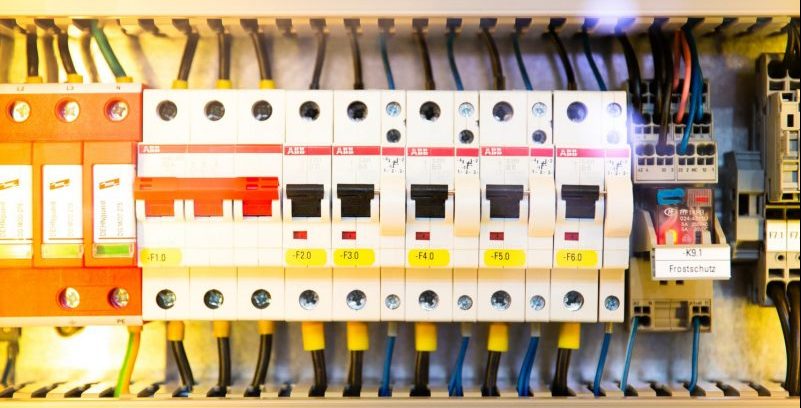
What to do when a Circuit Breaker Trips
When the lights suddenly go off generally your first thought is that there has been a power outage. But only your house has no power and when you check other parts of the house the power is still on there. The likeliest thing is that a circuit breaker has tripped. Most of the time this isn’t something you need to call an electrician about. A house circuit breaker tripping is a very common occurrence. All you need to do is follow these simple steps. That’s how to turn the power back on.
Main Reasons for Power Tripping
If it is dark, the first thing to do is find a torch or use your phone’s flashlight mode. You really don’t want to mess around inside your fuse box if you can’t see what you are doing. The next thing to do is to turn off and unplug all the appliances on the circuit that isn’t working. The two main reasons why you get an electricity trip are a circuit overload or a short circuit.
Circuit Overload
A circuit overload just means that you are running too many appliances at once and trying to draw more power than the circuit can provide. It’s pretty obvious that this is the cause of your problem if the power has tripped when you have put on way more things than usual, such as the toaster, an electric frypan, the kettle and a blender all at once while the fridge is running. Some circuits can handle this, but older homes can struggle with excess demand.
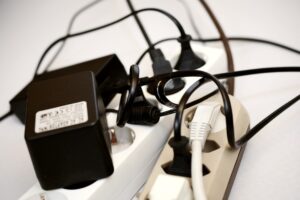
Short Circuit
A short circuit is usually caused by faulty appliances. That’s why the first thing to do is turn them all off at the socket and unplug them. Now it’s time to visit the fuse box. There are various places where this can be – outside, in the laundry or even in the garage. Mostly it houses both the switchboard and the meter, so people also call it the meter box or simply the switchboard. What you should see inside is a number of switches or breakers. The breaker that has switched off is the one that controls the circuit that has gone dead. Just turn it back on.
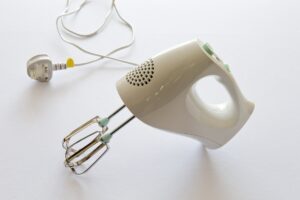
All should be well and the power to that circuit should come back on. If it doesn’t, and the breaker immediately trips again, it means the short circuit is in the system. That is something for an electrician to sort out. But otherwise, all you will have to sort out from here is which the offending appliance is. Finding out which appliance has caused the problem is simply a process of trial and error – plug an appliance in, turn it on and if it results in a tripped breaker then it’s the culprit.
People also ask…
How do you fix a breaker that keeps tripping.
Since they only cost a few dollars, if your breaker is faulty it should be replaced and not repaired. And breakers, as they are important electrical safety devices, should be installed a licensed electrician if you don’t want to void your insurance policy. You could also consider using fewer appliances on the circuit that keeps tripping.
Why is my breaker tripping all of a sudden?
A breaker can start tripping if it is being regularly overloaded. A new appliance that draws a lot of power might be the issue. If the breaker is tripping for no readily apparent reason it is advisable to have it checked by an electrician.
How do I find out what’s tripping my circuit breaker?
If you problem is a faulty appliance, it just a case of trying appliances one by one until you strike the one that trips the circuit breaker.
What causes a main circuit breaker to trip?
Lightning strikes and power surges can trip the main circuit breaker. If an individual circuit breaker fails and doesn’t trip for an overload or short circuit, the main breaker trips instead as a backup safety shutoff.
How do you fix a short circuit?
You fix a short circuit by removing the appliance that is causing it and throwing it away. For short circuits within the system caused by wiring faults, call a licensed electrician. Don’t create a fire hazard, get a certificate of compliance.
How much does it cost to replace a circuit breaker?
Circuit breakers only cost a few dollars. The rest is what your electrician will charge for roughly an hour’s labour.
What are the warning signs of an overloaded electrical circuit?
Lights dimming or flickering is one sign. Another is powerpoints getting warm and a burning smell. Powerpoints that buzz also indicate a problem. They’re not supposed to make a noise.
How many times can you trip a circuit breaker?
Quite a few, but if you are constantly tripping your circuit breaker it is advisable to resolve the issue that is causing the tripping.
How do I find out why my electricity keeps tripping?
If your electricity keeps tripping and it is not because you are overloading the circuit or have had an incredibly bad run of faulty appliances, you can find out by consulting an electrician.
How do you reset a tripped breaker?
Simply switch it back on after having turned off any appliances on the circuit.
What is the lifespan of a circuit breaker?
You can reasonably expect a circuit breaker to have a lifespan of 30 years or more.
How do you fix an overloaded circuit?
You can get an electrician to increase the capacity of a circuit or you can use fewer appliances on the circuit that is overloaded.
What happens when a short circuit occurs?
When a short circuit occurs your circuit breaker should trip and turn off the power to the circuit.
Can I replace a breaker myself?
We don’t advise doing things that really should be done by a licensed electrician.
Published: 2021-03-02
Recent Posts
Trusted Electrical Services This ANZAC Day
Why is My Electrical Powerpoint Not Working?
How LED Lighting Can Change Your Home
Are Exposed Wires a Safety Hazard?
Metropolitan Electrical Contractors Available All Easter

No Extra Charge After Hours
Metropolitan is available 24/7 for all your electrical requirements. Offering round-the-clock service, no additional weekend or public holiday charges, and flexible finance options**, your peace of mind is assured.
Electricians You Can Trust
Our Promise to You
We believe in transparency. We will guide you through our process, answer your questions and provide you with upfront, no obligation fixed prices.
No matter how big or small the job is, whether you're a new or returning customer, we treat every job as important and strive for success.
Professional
We know our job site is your home and we completely respect that. We arrive neat and clean, and tidy up after we've completed the job.

Now Available!
Interest free Electrical with trusted pay later options
What Our Happy Customers Have to Say
Better service starts here.
Simon was very professional and did excellent work. Provided clear explanations and very informative options for the job. An excellent result was achieved. Thanks again Simon for your help!
Ferris was on time and very professional. He understood straight away what was going on. He fixed the issue with my lights and even did a full electrical inspection. Very happy.
Angelo changed some circuits on my board that were damaged and causing the power to go off. He fixed it quickly and explained the damage. Absolute champion.

HPM are leaders in the Australian electrical industry and Metropolitan is available 24/7 to install and repair their products.

Metropolitan Electrical Contractors has experts at installing, repairing and servicing all Wilson electric hot water systems.

When you need an expert in Thermann electric hot water products, contact your local specialists.

When you need an expert in Vulcan's electric hot water systems, contact your local specialists.

We work with Stiebel Eltron electric hot water systems. When you need service you can trust, call Metropolitan Electrical Contractors.

When you need an expert in Rinnai's electric hot water systems, contact your local specialists.

Metropolitan Electrical Contractors is your local Schneider Electric specialist.

Did you know Metropolitan Electrical Contractors can install, service and repair all Rheem electric hot water systems?

For fast and efficient Philips electrical services, Metropolitan Electrical Contractors is your number one local expert.

Metropolitan Electrical Contractors is proud to use high quality brands such as Pierlite.

If you're after quality OMEGA electrical products for your home or business, call the experts at Metropolitan Electrical Contractors.

OSRAM electrical products are highly recommended by the expert team at Metropolitan Electrical Contractors.

Need an electrical expert who works with the NHP brand? Look no further than your local Metropolitan Electrical Contractors electricians.

When you need an expert in Hager electrical products you need Metropolitan Electrical Contractors.

Metropolitan Electrical Contractors is proud to work with high quality brands such as Legrand.

We are proud to work with high quality products such as Crompton Lighting. Metropolitan Electrical Contractors is a name you can trust.

When you need a Dux electric hot water installation, service or repair, call the team at Metropolitan Electrical Contractors.

Metropolitan Electrical Contractors is proud to work with high quality brands such as Clipsal.

Metropolitan Electrical Contractors are experts at installing, repairing and servicing Bosch electric hot water systems.

Did you know that Metropolitan Electrical Contractors supply, install and repair Chromagen electric hot water systems?

Metropolitan Electrical Contractors choose Australian owned and operated AquaMAX for a range of electric hot water services.

*Subject to Availability | **Conditions Apply
- VIC 49543 / REC 35055 |
- SA BLD244302 / PGE262113 |
- QLD 1277109 / 86376 |
- WA PL7618 / GF14476 / EC14063 |
- Popular Professionals
- Design & Planning
- Construction & Renovation
- Finishes & Fixtures
- Landscaping & Outdoor
- Systems & Appliances
- Interior Designers & Decorators
- Architects & Building Designers
- Design-Build Firms
- Kitchen & Bathroom Designers
- General Contractors
- Kitchen & Bathroom Remodelers
- Home Builders
- Roofing & Gutters
- Cabinets & Cabinetry
- Tile & Stone
- Hardwood Flooring Dealers
- Landscape Contractors
- Landscape Architects & Landscape Designers
- Home Stagers
- Swimming Pool Builders
- Lighting Designers and Suppliers
- 3D Rendering
- Sustainable Design
- Basement Design
- Architectural Design
- Universal Design
- Energy-Efficient Homes
- Multigenerational Homes
- House Plans
- Home Remodeling
- Home Additions
- Green Building
- Garage Building
- New Home Construction
- Basement Remodeling
- Stair & Railing Contractors
- Cabinetry & Cabinet Makers
- Roofing & Gutter Contractors
- Window Contractors
- Exterior & Siding Contractors
- Carpet Contractors
- Carpet Installation
- Flooring Contractors
- Wood Floor Refinishing
- Tile Installation
- Custom Countertops
- Quartz Countertops
- Cabinet Refinishing
- Custom Bathroom Vanities
- Finish Carpentry
- Cabinet Repair
- Custom Windows
- Window Treatment Services
- Window Repair
- Fireplace Contractors
- Paint & Wall Covering Dealers
- Door Contractors
- Glass & Shower Door Contractors
- Landscape Construction
- Land Clearing
- Garden & Landscape Supplies
- Deck & Patio Builders
- Deck Repair
- Patio Design
- Stone, Pavers, & Concrete
- Paver Installation
- Driveway & Paving Contractors
- Driveway Repair
- Asphalt Paving
- Garage Door Repair
- Fence Contractors
- Fence Installation
- Gate Repair
- Pergola Construction
- Spa & Pool Maintenance
- Swimming Pool Contractors
- Hot Tub Installation
- HVAC Contractors
- Electricians
- Appliance Services
- Solar Energy Contractors
- Outdoor Lighting Installation
- Landscape Lighting Installation
- Outdoor Lighting & Audio/Visual Specialists
- Home Theater & Home Automation Services
- Handyman Services
- Closet Designers
- Professional Organizers
- Furniture & Accessories Retailers
- Furniture Repair & Upholstery Services
- Specialty Contractors
- Color Consulting
- Wine Cellar Designers & Builders
- Home Inspection
- Custom Artists
- Columbus, OH Painters
- New York City, NY Landscapers
- San Diego, CA Bathroom Remodelers
- Minneapolis, MN Architects
- Portland, OR Tile Installers
- Kansas City, MO Flooring Contractors
- Denver, CO Countertop Installers
- San Francisco, CA New Home Builders
- Rugs & Decor
- Home Improvement
- Kitchen & Tabletop
- Bathroom Vanities
- Bathroom Vanity Lighting
- Bathroom Mirrors
- Bathroom Fixtures
- Nightstands & Bedside Tables
- Kitchen & Dining
- Bar Stools & Counter Stools
- Dining Chairs
- Dining Tables
- Buffets and Sideboards
- Kitchen Fixtures
- Wall Mirrors
- Living Room
- Armchairs & Accent Chairs
- Coffee & Accent Tables
- Sofas & Sectionals
- Media Storage
- Patio & Outdoor Furniture
- Outdoor Lighting
- Ceiling Lighting
- Chandeliers
- Pendant Lighting
- Wall Sconces
- Desks & Hutches
- Office Chairs
- View All Products
- Designer Picks
- Side & End Tables
- Console Tables
- Living Room Sets
- Chaise Lounges
- Ottomans & Poufs
- Bedroom Furniture
- Nightstands
- Bedroom Sets
- Dining Room Sets
- Sideboards & Buffets
- File Cabinets
- Room Dividers
- Furniture Sale
- Trending in Furniture
- View All Furniture
- Bath Vanities
- Single Vanities
- Double Vanities
- Small Vanities
- Transitional Vanities
- Modern Vanities
- Houzz Curated Vanities
- Best Selling Vanities
- Bathroom Vanity Mirrors
- Medicine Cabinets
- Bathroom Faucets
- Bathroom Sinks
- Shower Doors
- Showerheads & Body Sprays
- Bathroom Accessories
- Bathroom Storage
- Trending in Bath
- View All Bath
- Houzz x Jennifer Kizzee
- Houzz x Motivo Home
- How to Choose a Bathroom Vanity

- Patio Furniture
- Outdoor Dining Furniture
- Outdoor Lounge Furniture
- Outdoor Chairs
- Adirondack Chairs
- Outdoor Bar Furniture
- Outdoor Benches
- Wall Lights & Sconces
- Outdoor Flush-Mounts
- Landscape Lighting
- Outdoor Flood & Spot Lights
- Outdoor Decor
- Outdoor Rugs
- Outdoor Cushions & Pillows
- Patio Umbrellas
- Lawn & Garden
- Garden Statues & Yard Art
- Planters & Pots
- Outdoor Sale
- Trending in Outdoor
- View All Outdoor
- 8 x 10 Rugs
- 9 x 12 Rugs
- Hall & Stair Runners
- Home Decor & Accents
- Pillows & Throws
- Decorative Storage
- Faux Florals
- Wall Panels
- Window Treatments
- Curtain Rods
- Blackout Curtains
- Blinds & Shades
- Rugs & Decor Sale
- Trending in Rugs & Decor
- View All Rugs & Decor
- Pendant Lights
- Flush-Mounts
- Ceiling Fans
- Track Lighting
- Wall Lighting
- Swing Arm Wall Lights
- Display Lighting
- Table Lamps
- Floor Lamps
- Lamp Shades
- Lighting Sale
- Trending in Lighting
- View All Lighting
- Bathroom Remodel
- Kitchen Remodel
- Kitchen Faucets
- Kitchen Sinks
- Major Kitchen Appliances
- Cabinet Hardware
- Backsplash Tile
- Mosaic Tile
- Wall & Floor Tile
- Accent, Trim & Border Tile
- Whole House Remodel
- Heating & Cooling
- Building Materials
- Front Doors
- Interior Doors
- Home Improvement Sale
- Trending in Home Improvement
- View All Home Improvement
- Cups & Glassware
- Kitchen & Table Linens
- Kitchen Storage and Org
- Kitchen Islands & Carts
- Food Containers & Canisters
- Pantry & Cabinet Organizers
- Kitchen Appliances
- Gas & Electric Ranges
- Range Hoods & Vents
- Beer & Wine Refrigerators
- Small Kitchen Appliances
- Cookware & Bakeware
- Tools & Gadgets
- Kitchen & Tabletop Sale
- Trending in Kitchen & Tabletop
- View All Kitchen & Tabletop
- Storage & Organization
- Baby & Kids
- Housekeeping & Laundry
- Pet Supplies

- View all photos
- Dining Room
- Breakfast Nook
- Family Room
- Bed & Bath
- Powder Room
- Storage & Closet
- Outdoor Kitchen
- Bar & Wine
- Wine Cellar
- Home Office
- Popular Design Ideas
- Kitchen Backsplash
- Deck Railing
- Privacy Fence
- Small Closet
- Stories and Guides
- Popular Stories
- Renovation Cost Guides
- Fence Installation Cost Guide
- Window Installation Cost Guide
- Discussions
- Design Dilemmas
- Before & After
- Houzz Research
- View all pros
- View all services
- View all products
- View all sales
- Living Room Chairs
- Dining Room Furniture
- Coffee Tables
- Home Office Furniture
- Join as a Pro
- Interior Design Software
- Project Management
- Custom Website
- Lead Generation
- Invoicing & Billing
- Landscape Contractor Software
- General Contractor Software
- Remodeler Software
- Builder Software
- Roofer Software
- Architect Software
- Takeoff Software
- Lumber & Framing Takeoffs
- Steel Takeoffs
- Concrete Takeoffs
- Drywall Takeoffs
- Insulation Takeoffs
- Stories & Guides
- LATEST FROM HOUZZ
- HOUZZ DISCUSSIONS
- SHOP KITCHEN & DINING
- Kitchen & Dining Furniture
- Sinks & Faucets
- Kitchen Cabinets & Storage
- Knobs & Pulls
- Kitchen Knives
- KITCHEN PHOTOS
- FIND KITCHEN PROS
- Bath Accessories
- Bath Linens
- BATH PHOTOS
- FIND BATH PROS
- SHOP BEDROOM
- Beds & Headboards
- Bedroom Decor
- Closet Storage
- Bedroom Vanities
- BEDROOM PHOTOS
- Kids' Room
- FIND DESIGN PROS
- SHOP LIVING
- Fireplaces & Accessories
- LIVING PHOTOS
- SHOP OUTDOOR
- Pool & Spa
- Backyard Play
- OUTDOOR PHOTOS
- FIND LANDSCAPING PROS
- SHOP LIGHTING
- Bathroom & Vanity
- Flush Mounts
- Kitchen & Cabinet
- Outdoor Wall Lights
- Outdoor Hanging Lights
- Kids' Lighting
- Decorative Accents
- Artificial Flowers & Plants
- Decorative Objects
- Screens & Room Dividers
- Wall Shelves
- About Houzz
- Houzz Credit Cards
- Privacy & Notice
- Cookie Policy
- Your Privacy Choices
- Mobile Apps
- Copyright & Trademark
- For Professionals
- Houzz vs. Houzz Pro
- Houzz Pro vs. Ivy
- Houzz Pro Advertising Reviews
- Houzz Pro 3D Floor Planner Reviews
- Trade Program
- Buttons & Badges
- Your Orders
- Shipping & Delivery
- Return Policy
- Houzz Canada
- Review Professionals
- Suggested Professionals
- Accessibility
- Houzz Support
- COUNTRY COUNTRY
circut breaker trips everytime I turn off lights
I tried to install two recessed lights in series in a 57 year old house. The new fixtures don't use wire nuts they come with a plug type connection. I used the existing wiring to the first fixture and new wiring between the first and second fixture then the existing wiring from the second fixture. I hooked up the hot to hot and neutral to neutral. The new fixtures and new wire, have a ground however there is no ground in the original wiring. I have connnected the ground in the new wiring to that of the fixtures. When i turn the light switch to the on position and then turn on the circuit breaker the lights come on. When I turn off the lights it trips the circuit breaker. I tried to check the connections, and while the light switch was in the off positon, I then tried to flip the breaker and it trips immediately.
I thought the polarity may be reversed so i plugged in the existing netural into the new hot connection and the existing hot into the new neutal connection. but the same results.
Please help with any advise.
Ron Natalie
JOED hit it.
I can almost guarantee you have a switch loop setup and you connected all the whites and all the blacks together. The light is on when the switch is off. The circuit is shorted (and the breaker trips) when the switch is on.
The way this needs to be wired:
Black wire to circuit breaker goes to white wire (please remark it black on both the switch and the light end) and to black wires for cables going out to other devices.
White wire from the circuit breaker goes to the white wire of the light (and white wires of other devices).
Black wire from the switch to the black wire of the light.
All bare/ground wires connected together and to the ground screw on the lighting fixture and on the box (if metal or a plastic one with a grounding provision).
This is a pretty common mistake by diy-ers.
Comments (24)
You have miswired a switch loop. There was probably a white and black connected together that you thought you should correct because the colours didn't match. You are actually turning on the light switch when the breaker trips.
Is the switch upside down? Is the switch a single pole or a 3 way?
Related Professionals
Js981113 original author.
to tell you the truth, when i took the old fixture off i didn't look to see how it was wired, i just assumed it was wired the conventional way. i'll look to see if they wired a white and black togeather.
I have not dug into the switch yet. I believe it is in-fact a single pole. I don't know of another switch. I'll look to be sure.
Ive been thinking, the existing cable went from the switch to the fixture, then the existing cable continued from the switch to something else. So there must be something else controlled by the switch. either way it looks like i'm going to have to find where the cable goes.
This likely what you have.
I have diagrams i would like to post. joed, could you let me know how you posted the diagram from MS paint.
You need to host the drawing some place like photobucket. then use the following code replacing () with . It is standard HTML coding.
(img src="insert direct link to image"/img)
Below is my existing wiring diagram
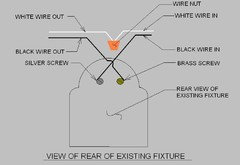
Below is my proposed wiring diagram
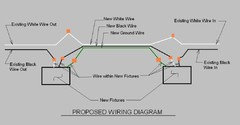
Last night i followed my proposed wiring diagram and it worked...kind of. As expected for one light to work both fixtures needed a light bulb, but what really got my attention was the intensity of the bulbs.
When I plugged in one regular 75W light bulb and a compact florecent bulb (CFL), the CFL was bright and seemed normal, however the 75W bulb barely lit up. I then switched bulbs in the lights fixtures and the same result, thus ruling out a bad fixture.
I then tried two 75W bulbs and they lit up, however they were much dimmer than I expected. Why would this be the case? I know the CFL, although rated as a 100W acutally uses 35W or 45W. So with that said, is the wattage to the fixtures low. Which would lead me to think the old wiring has a low current carring capacity, is this also correct? and if so what can i do about it, other than replacing all the wires?
You have wired the two fixtures in series. They need to be in parallel from the switched hot to neutral.
Yep - you are running the power through a resistor ie the light and then on to power another resistor ie the second light. That is where the drop is occurring and why the bulbs dim.
Basically, you need live and neutral coming in. The live needs to go down to the switch loop and then return. The return should be marked black. Then, the live should go to both the black wires for the lights, not through one light and onto the next. The whites from both lights should be connected to the neutral in.
This thread has a sample diagram with 3 lights on a switch loop.
Here is a link that might be useful: parallel
The fixtures are series wired. You need to connect the black wires together and to the gold screw. Connect the white together and to the silver screw.
Ok. I've looked at joed's last post and have come up witha new wiring diagram of which i have tried to show is parallel.
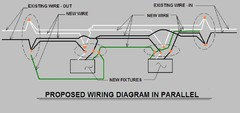
What do i do with the ground wire in the new cable, when trying to connect to the existing wire going out?
Unless your old existing cable has a grounded metallic sheath terminating into metal boxes, do NOT connect the "ground wires" in the new cable to ANYTHING - including each other. Cap them off individually at both ends.
Attaching ungrounded "ground" wires between fixtures only ensures that a ground fault on one fixture will also make the other fixture hot.
Based on your wild misunderstanding of the "conventional" way to wire light fixtures, I'm thinking that you really need to buy and study a basic wiring book or hire a local licensed electrician.
I almost wrote this up last night.
If in wires are from main panel and out wires are to switch, then
In white to both lights
in black to out white, remark white to black
Out black to both lights
cap all grounds
fasten to switch out white remarked black and out black
if the first statement is not true then disregard all this
The main problem you have here is two blacks going to a light fixture. Each fixture needs a black and a white in order to operate properly.
"Based on your wild misunderstanding of the "conventional" way to wire light fixtures, I'm thinking that you really need to buy and study a basic wiring book or hire a local licensed electrician."
I have to agree. I know this is a DIY site, but when it comes to something like electricity the DIY should at least take the time to gain some knowledge on theory and circuits, and learn some basics before diving in. Getting it to work by trial and error is not a good idea at all, and with no knowledge of what you are doing can be a dangerous thing. Sure eventually you can get it to work, but how safe will it be? Have you considered the fact that the circuit breaker is possibly damaged from the repeated short circuiting and should be replaced?
Hello js981113
The lights should be wired in parallel. Here is your diagram, that I revised on how to re-wire your lights.
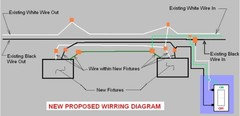
Hope this helps let us know how you made out with your project!!
Have A Nice Day Linesman
terribletom
Yep, Linesman's diagram makes for a righteous fix.
That is, it'll work depending on where the switch is. I've been lurking on this thread and never have been able to figure out where the switch loop is located.
(I feel your pain on that, Hendricus! I started a similar reply last night and then deep-sixed it because of that uncertainty.)
So...if the switch loop is somewhere other than where Linesman has put it, then stop back in for further alterations.
Gotta agree with a couple of the others, too. Without understanding how the circuitry works, this trial-and-error approach is a tad scary to say the least.
Dave Becker
This thread helped me a lot thanks
Woody Woodford
I have exactly the same problem as the original poster. I am also a lot less knowledgable and don’t have the black and white wires referred to in the probable solution. Any plain English suggestions welcome. 🤞🏻
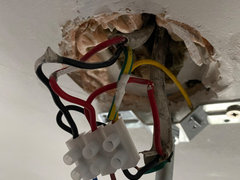
HU-719434043
Assuming one set of wires are power and the other set are the switch. The two red wires should be joined together and only to each other. One black wire should be joined to the blue second live wire and one black wire should be joined to the brown first live wire. The black wire that connects to the brown first live wire should be identified with a wrapper of red insulation tape to show that it is indeed the live switch feed.
Grinders Contracting
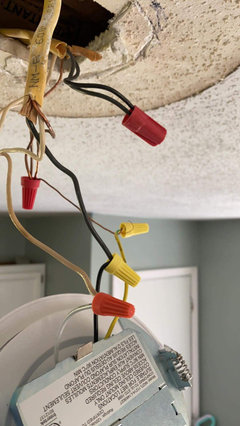
Light comes on in kitchen and laundry room but when i hit the switch it trips the breaker.
HU-143678890
Same issue here, only my breaker box is 25' from the door of my crawlspace and I got tired of going under there and quit for today. Just left the light on while the switch says off. I am sure I wired the new light the same as the old one was wired. It's the end of a 3 fixture string. There are 2 black, a white, a grey, and a ground. The 2 blacks were with the black on the fixture. The white and grey were with the white of the fixture. The ground to the ground. I mean, that's simple, right? How could I have messed that up? Now the switch is in the off position and the light is on. Turn it off and trip the breaker. Keep the switch at off and reset the breaker and it trips immediately. I plan to undo and redo it tomorrow, but I don't fathom any new result. Any thoughts and/or advice? I am not a professional but I do reviews for Kichler so I've installed and/or replaced more ceiling fixtures than I can count and thus has never happened before. Thanks- Karen
BUSINESS SERVICES
Connect with us.
- PRO Courses Guides New Tech Help Pro Expert Videos About wikiHow Pro Upgrade Sign In
- EDIT Edit this Article
- EXPLORE Tech Help Pro About Us Random Article Quizzes Request a New Article Community Dashboard This Or That Game Popular Categories Arts and Entertainment Artwork Books Movies Computers and Electronics Computers Phone Skills Technology Hacks Health Men's Health Mental Health Women's Health Relationships Dating Love Relationship Issues Hobbies and Crafts Crafts Drawing Games Education & Communication Communication Skills Personal Development Studying Personal Care and Style Fashion Hair Care Personal Hygiene Youth Personal Care School Stuff Dating All Categories Arts and Entertainment Finance and Business Home and Garden Relationship Quizzes Cars & Other Vehicles Food and Entertaining Personal Care and Style Sports and Fitness Computers and Electronics Health Pets and Animals Travel Education & Communication Hobbies and Crafts Philosophy and Religion Work World Family Life Holidays and Traditions Relationships Youth
- Browse Articles
- Learn Something New
- Quizzes Hot
- This Or That Game
- Train Your Brain
- Explore More
- Support wikiHow
- About wikiHow
- Log in / Sign up
- Home and Garden
- Home Maintenance
- Electrical Maintenance
Reasons Your Circuit Breaker Keeps Tripping (Plus, What to Do)
Last Updated: March 11, 2024 Fact Checked
- Causes for a Tripped Breaker
- Fixing a Tripped Breaker
Is it dangerous for a breaker to trip?
This article was co-authored by Jesse Kuhlman and by wikiHow staff writer, Mason Martinez, BA . Jesse Kuhlman is a Master Electrician and the Owner of Kuhlman Electric based in Massachusetts. Jesse specializes in all aspects of home and residential wiring, troubleshooting, generator installation, and WiFi thermostats. Jesse is also the author of four eBooks on home wiring including "Residential Electrical Troubleshooting" which covers basic electrical troubleshooting in residential homes. There are 16 references cited in this article, which can be found at the bottom of the page. This article has been fact-checked, ensuring the accuracy of any cited facts and confirming the authority of its sources.
You may be familiar with tripping a breaker because of too many plugged-in appliances, but what about when there's nothing plugged in? Well, it's unlikely that nothing is plugged in unless you're living off the grid. So, before you get ready to peel back some wires, double-check inside and outside your house for any forgotten appliances. Then, grab this guide to learn more about the common causes of a tripped breaker!
What causes a breaker to trip if nothing is plugged in?
When electrical demand is high, a circuit breaker can overheat and trip. Wire damage can also cause tripping, so check for signs of burning, cracking, or sparking when you plug a device in, as this can mean wire damage. Damaged wires or GFCIs may also cause trips when they touch another live wire or outlet box.
Why does my breaker keep tripping?

- For a 20-amp circuit, you can put a maximum of 16 outlets on it. Meanwhile, a 15-amp circuit can handle 12 outlets. [2] X Research source
- Unplug unused electronics or avoid using two demanding appliances at once if you don't know how to wire a circuit breaker to redistribute appliances or add new circuits.
- If your circuit breaker frequently trips, this may be a sign that it's time to replace your breaker.
- Cost: $200 to $600 to replace a main breaker or $150 to $1,000 for rewiring. [3] X Research source

- If you're an experienced electrician, locate the short circuit within the wiring system and make a new wire to replace the damaged one. Remove insulation from the ends of the new wire and solder them in place. [5] X Research source
- If you're unfamiliar with wiring, it's best to call an electrician for assistance as soon as possible to avoid an electrical fire!
- Cost: Fixing a short circuit can cost $75 to $200. [6] X Research source

- GFCIs are often installed in wet environments, like bathrooms or kitchens. Any lingering water can create a new path for electricity to flow. Be sure the outlet is dry before inspecting it.
- Unplug all the appliances from the circuit and press the reset button on the GFCI. Plug in your electronics one by one to determine the cause of the trip. If it continues to trip, call an electrician. [8] X Research source
- Cost: A replacement can cost between $100 to $400. [9] X Research source

- Cost: If your home lacks power surge protection, a whole house installation can cost between $70 to $700. [11] X Research source

- You can also use an electronic circuit breaker finder to map out which outlets are connected to which breakers. [13] X Research source
How to Fix a Tripped Breaker

- If the circuit breaker continues to flip and you can't identify which appliance is causing it, call a licensed electrical contractor to find the source of the problem.

Expert Q&A
You Might Also Like

- ↑ https://www.homelectrical.com/understanding-capacity-your-circuit-breaker.6.html
- ↑ https://todayshomeowner.com/electrical/guides/how-many-outlets-on-a-15-amp-circuit/
- ↑ https://homeguide.com/costs/cost-to-replace-a-circuit-breaker-switch
- ↑ https://www.rowse.co.uk/blog/post/what-causes-circuit-breakers-to-trip
- ↑ https://www.thelocalelectrician.com.au/how-to-fix-short-circuits/
- ↑ https://www.fixr.com/costs/electrical-outlet-repair
- ↑ https://gopaschal.com/why-does-my-circuit-breaker-keep-tripping/
- ↑ https://www.mistersparky.com/denver/about-us/blog/2023/february/fix-a-gfci-outlet-that-keeps-tripping/
- ↑ https://www.angi.com/articles/how-much-should-it-cost-electrician-replace-combination-gfci-switch-and-receptacle.htm
- ↑ https://www.sunpower-uk.com/glossary/what-is-a-power-surge/
- ↑ https://www.bobvila.com/articles/whole-house-surge-protector-cost/
- ↑ https://kolbelectric.com/blog/5-reasons-circuit-breaker-tripping/
- ↑ https://youtu.be/niJtOOPfMXg?t=161
- ↑ https://www.johnmooreservices.com/how-to-safely-reset-a-tripped-breaker/
- ↑ https://energized.edison.com/stories/a-step-by-step-guide-to-safely-resetting-your-breakers
- ↑ https://www.tingfire.com/home-safety/what-every-homeowner-should-know-about-resetting-circuit-breakers/
About This Article

- Send fan mail to authors
Did this article help you?

Featured Articles

Trending Articles

Watch Articles

- Terms of Use
- Privacy Policy
- Do Not Sell or Share My Info
- Not Selling Info
wikiHow Tech Help Pro:
Develop the tech skills you need for work and life

IMAGES
VIDEO
COMMENTS
This miswiring causes the light to turn on even though the switch is off. Because it's improper, it shorts the circuit and trips the breaker when the switch's on. To properly rewire this connection, you will need a marker and proceed to the following steps: First, the circuit breaker's black wire connects to the white wire and other black ...
The breaker can trip even when a switch is turned off. If your electrical circuit is not distributing current properly, reconfigure and reduce the number of loads if needed. Breaker Malfunction. There might be cases where the breaker is faulty, leading to unintentional trips. Replace the breaker with a new one if you find that the breaker is ...
The circuit breaker for our kitchen lights trips instantly when I turn on ANY light switch on that circuit. It is 6-month-old new construction and everything worked just fine until a week ago. And then this behavior suddenly started without us changing anything. It is a 15A circuit with five switches:
Devices charging slowly. Electrical outlets not working. Flickering lights. Scorch marks on outlets and light switches. If a circuit breaker keeps tripping in one room, homeowners can test for ...
Find out the cost to replace an electrical panel. On every breaker, there will be an "On" and "Off" position. On a tripped breaker, the handle will be in the middle, neither On nor Off. To reset, flip the handle to Off first, then to On. Stand to the side of the panel and turn your face away when flipping breakers.
Reasons Light Switch Trips Breaker. 1. Light Fixture Fault. If a light fixture is faulty, a breaker can become overloaded. The wires in an old light fixture can fall apart and cause a short or ground out. Turn off power before checking the light fixture for damage. Replace the light fixture if found to be faulty. 2.
answered Jul 4, 2013 at 5:49. 24 2. Add a comment. Somewhere in your light circuit there was a short circuit that caused the breaker to trip. By repeatedly trying to reset the breaker, the point at which the fault occurred finally blew itself apart. Now instead of having a short circuit you have an open circuit.
All you can do now is isolate each load (room) hot and common. Test the first section from the breaker to the begining of the first load. If the breaker holds, that section is good. connect the second section of load and test... and so on until you add a section that trips the breaker... - JACK. Sep 14, 2019 at 21:28.
If you suspect a short circuit, unplug your appliances and check the wires for melted coverings. You might also notice a burning smell coming from the outlet. Call in a professional electrician to find the source of the problem. 3. Circuit Overload. Circuit overloads are the most common reason that a breaker trips.
Circuit Breaker Tripping: Troubleshooting Guide. A circuit breaker tripping results from short circuits, overloaded circuits, and ground faults. In each case, an unintended excessive flow of current triggers the trip. You must reset the circuit breaker by flipping it back on to restore power.
This is a common issue with newly installed lighting systems. However, circuit breaker trips from flipping a light switch may also be caused by a short circuit due to faulty or damaged wires. Either way, let's take a look at how you can approach the tripped breaker. Turn Appliances and Devices Off
Find your circuit box and search for the breaker (s) in the OFF position. Some circuit breakers have a red or orange color if they are switched OFF. Flip the breaker from OFF to ON. Then, simply turn back on the appliances and devices you turned off in step 1, and you should be fine. If your circuit breaker keeps tripping, it's time to call ...
What Causes a Tripped Circuit Breaker . Overloaded circuits: When too many devices are operating on the same circuit and are attempting to pull a higher power load than the circuit can carry, the circuit breaker will trip.; High-power devices: High amp devices like microwaves, dryers, wall heaters, or A/Cs are turned on for sustained periods, they can cause a power breaker trip.
Step 1: Inspect the Circuit. Begin by inspecting every device or outlet in the area of your home that has lost power. Turn off all lights and unplug any appliances plugged into an outlet. As you unplug appliances, pay attention to any cords that looked damaged or are very hot to the touch. If you determine an appliance is damaged or has ...
Short Circuit. A short circuit is usually caused by faulty appliances. That's why the first thing to do is turn them all off at the socket and unplug them. Now it's time to visit the fuse box. There are various places where this can be - outside, in the laundry or even in the garage. Mostly it houses both the switchboard and the meter, so ...
Turn Off Affected Lights and Appliances. In addition to your circuit breaker tripping, the last thing you need is to blow the fuse on your living room television or other major appliances. Not only will you not have power, but you'll have a very unhappy household too. To prevent this problem, make sure you turn off all major electronic ...
The light is on when the switch is off. The circuit is shorted (and the breaker trips) when the switch is on. The way this needs to be wired: Black wire to circuit breaker goes to white wire (please remark it black on both the switch and the light end) and to black wires for cables going out to other devices.
Nov 16, 2014 at 14:36. 1. What was done wrong is that you connected something you shouldn't have, or left something exposed which is making contact that it shouldn't. Beyond that, we'd need to know exactly what you did, preferably with photos. - keshlam. Nov 16, 2014 at 15:14. Add a comment. By clicking "Post Your Answer", you agree to ...
When experiencing electrical imbalances, GFCI outlets trip much quicker to protect people from electrocution. If you hit the "test" button and it does not click, the GFCI has tripped. By pressing "reset" until you feel it click, you can restore the power to the outlet and any outlets downstream. Other issues can include loose wiring or ...
Turn the breaker fully off before flipping it back on. To reset a circuit breaker, if the switch is in the middle position, flip it to the "OFF" position. Then, flip it back to the "ON" position to restore power. You should hear or see power resume in the affected room. Plug each appliance individually to see if the circuit breaker trips again.
The 15a breaker came with the panel. I wired the lights by pushing the 14/2 wires into the supplied "auto-crimp" connectors. I wired the switch (es) by adding 6" leads to all four poles. Both grounds were connected to the box and I used a marette to connect the ground from the switch. Neutral / white was connected with a marette between switch ...
1) Always turn the circuit breaker off, and use a voltmeter or test light to make sure you are not dealing with any live circuits.2) This video is intended f...
1. If the breaker trips right when you turn on the switch, then there is a short. Either a ground wire touching the switch hot (why some switches have tape wrap around them) or there is a short somewhere between the switch and light. - crip659. Nov 6, 2023 at 18:20. 1. ↑ If the only change is the fixture, that would be the first place to ...